Petty Blue
— A look back to the famous “Petty Blue” Mopar® racecars
— How the famous color was “accidentally” created
— Highlights from the “Glory Days” of HEMI® domination in NASCAR
You’d be hard-pressed to find someone who’s never heard of Richard Petty. This year, they are celebrating the 75th year of racing. He’s called “The King” and is a true folk hero in the world of Stock Car Racing. For decades, his racecars have been instantly recognizable worldwide and have done wonders for the advancement of the NASCAR scene by helping it become a well-known and mainstream sport. Who could ever had imagined that a kid from Level Cross, North Carolina, an unincorporated area near Randleman, would go on to have such a huge and massive positive impact on American motorsports?
1959 saw a young Richard Petty behind the wheel of a white 1959 Plymouth racecar, with his #43 number in dark red; and in July of that year, he was able to pick up his first victory on the track, winning a 200 lapper in Columbia, South Carolina. He was named NASCAR’s “Rookie of the Year” in ’59, which was a fantastic way to kick-off his driving career!
THE MOST FAMOUS COLOR IN ALL OF MOTORSPORTS
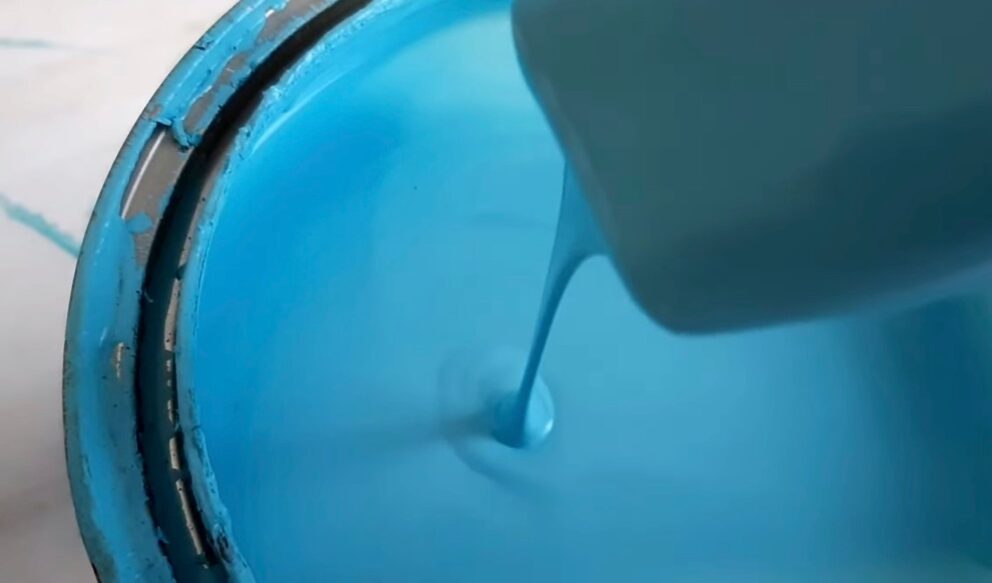
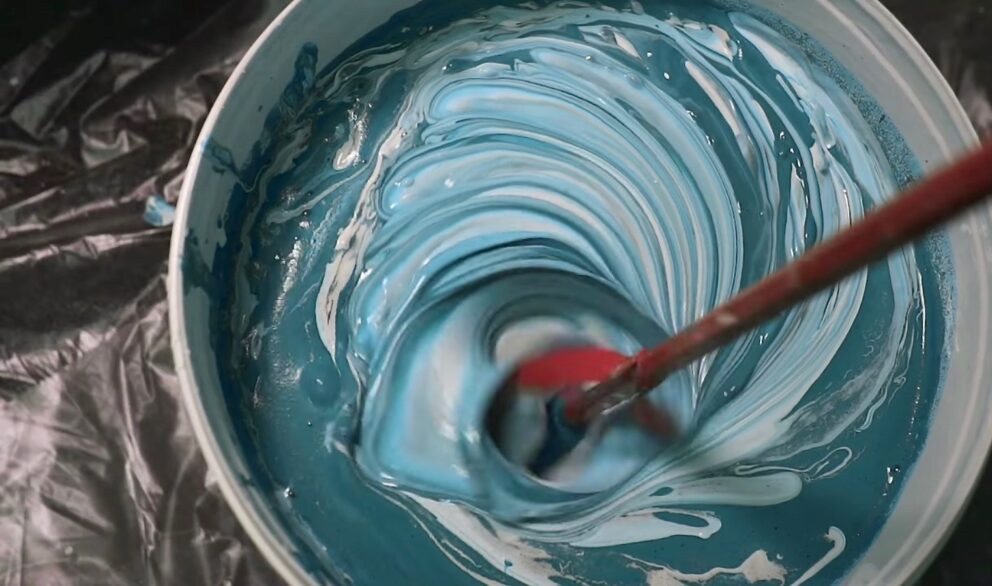
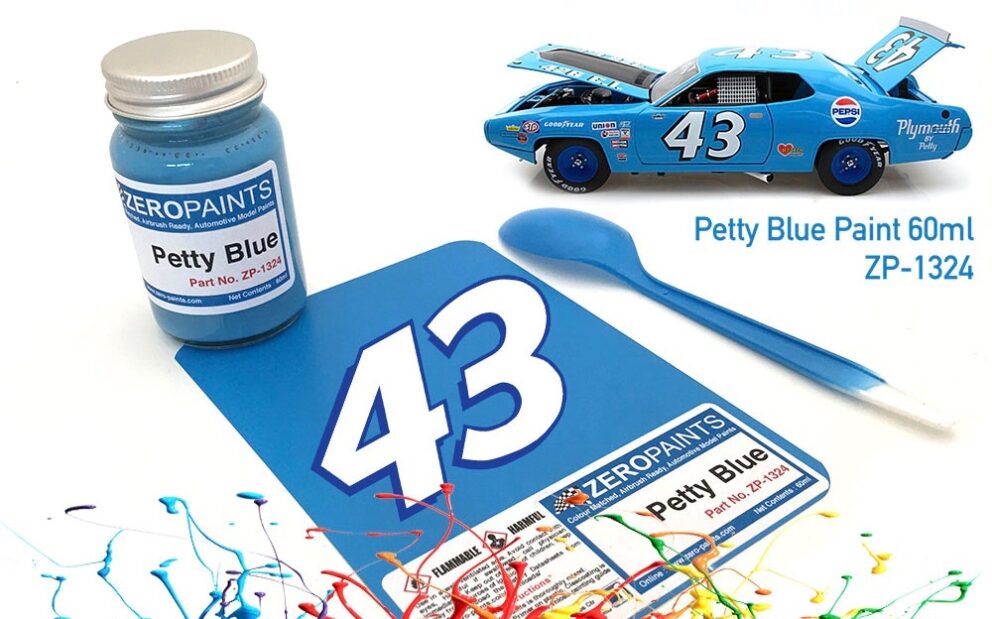
Richard and his brother Maurice “invented” the color, sort of by accident. Their father was out of town and told them to paint the family racecar, it was 2 or 3 in the morning, and there wasn’t enough white paint (which is what father Lee Petty ran) and there was some blue paint in the shop, however, not enough to paint the entire car. So the brothers just looked at one another and dumped both cans together and mixed it up. “The mixture started life as ’57 Chevrolet White, which is Refrigerator White, and ’55 Dodge Blue, which is Indigo Blue,” as told by Richard in a Mopar Muscle interview. “When it was finished, we said ‘Man, that’s pretty!'”
1960: RICHARD’S FIRST FULL SEASON
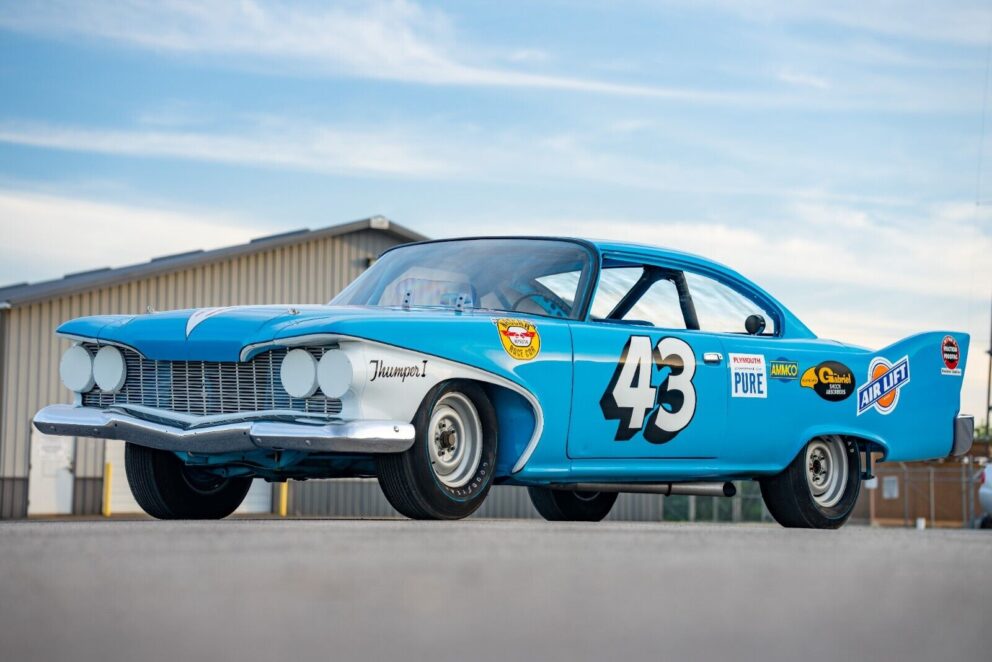
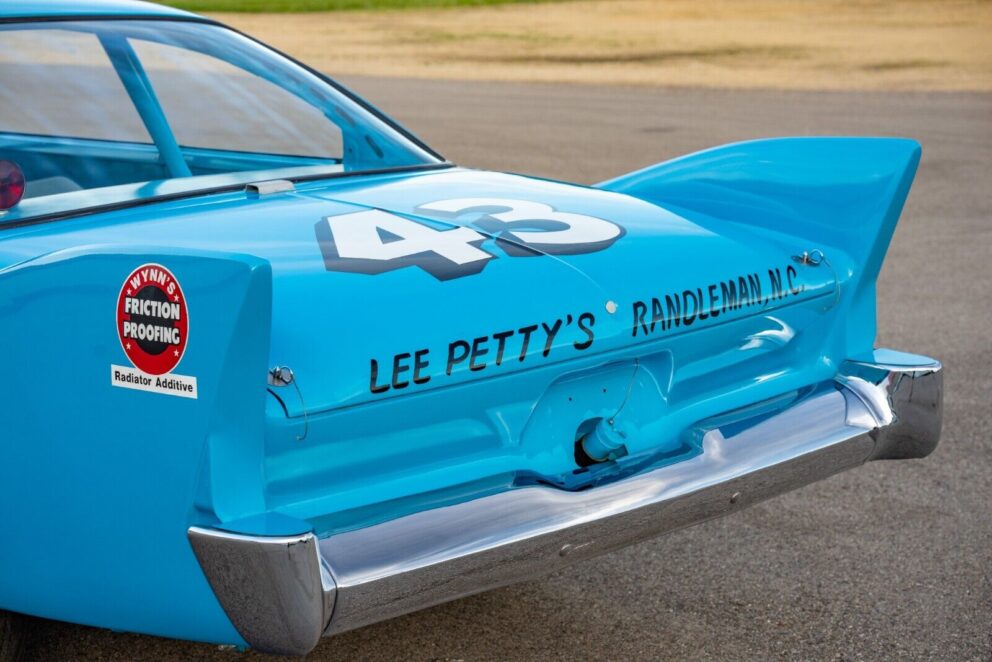
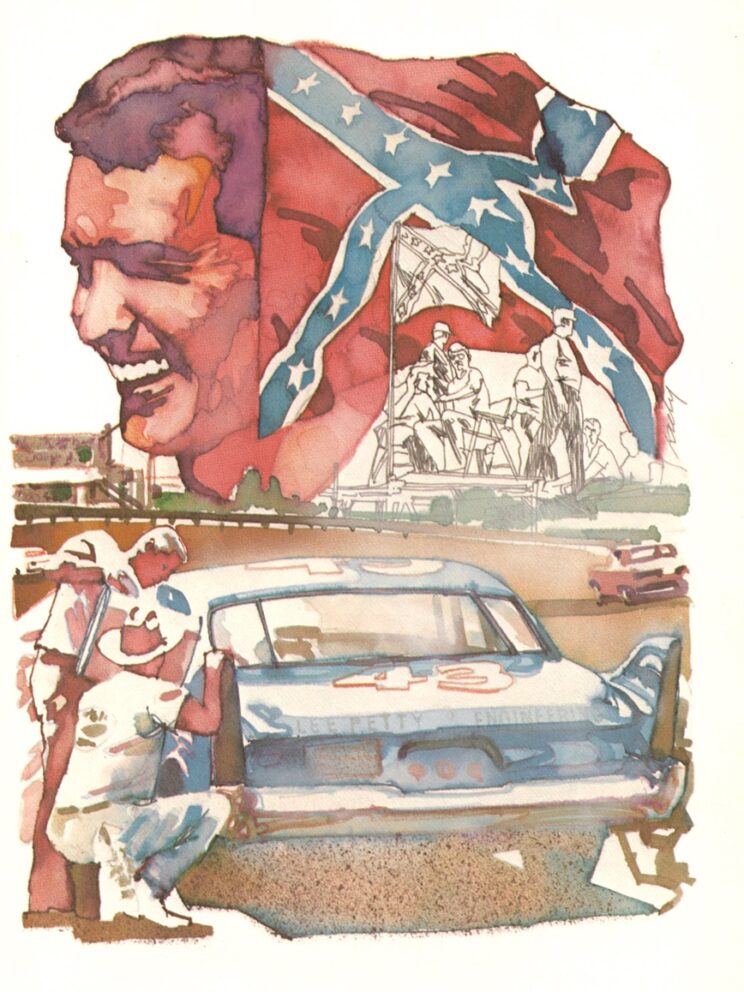
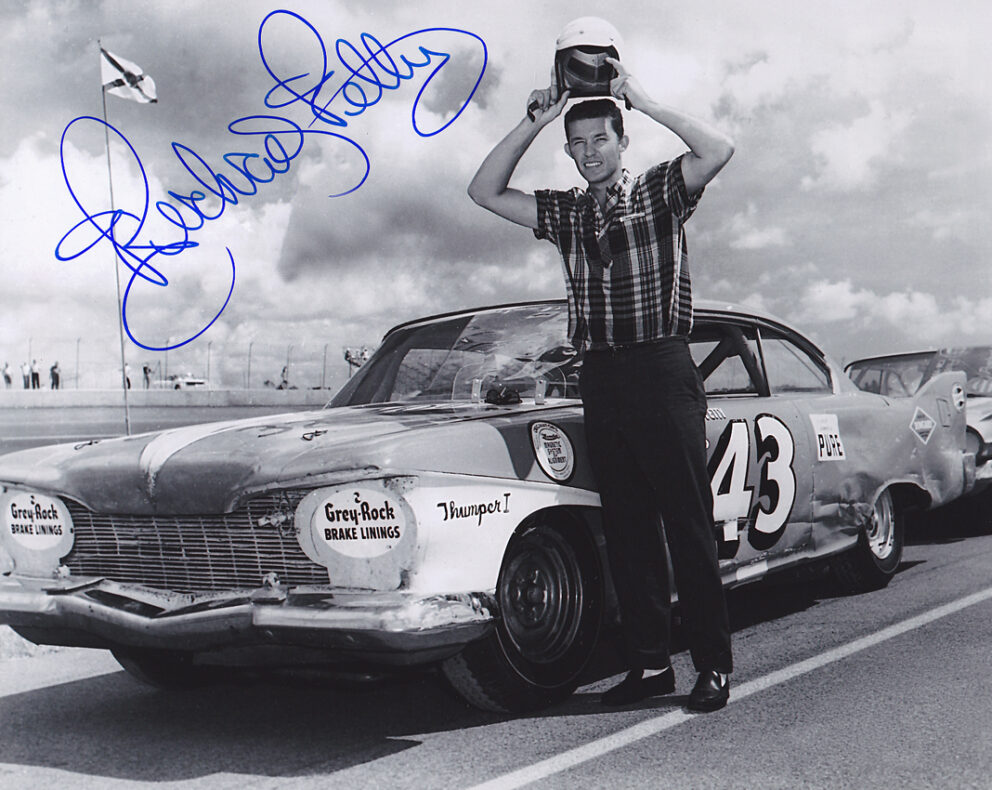
The newly created Petty Blue color was a visual change that was incorporated into the new Plymouth Fury hardtop racecar for 1960. A “high deck” 383-cid RB engine was used, and he was able to finish in third place at the Daytona 500 that year. Some years back, the car was found and well-known expert NASCAR restorer Kim Haynes handled the “bringing back” of the car, and it was authenticated by Richard Petty.
LEE PETTY RACES IN THE NEW COMPACT CAR SERIES
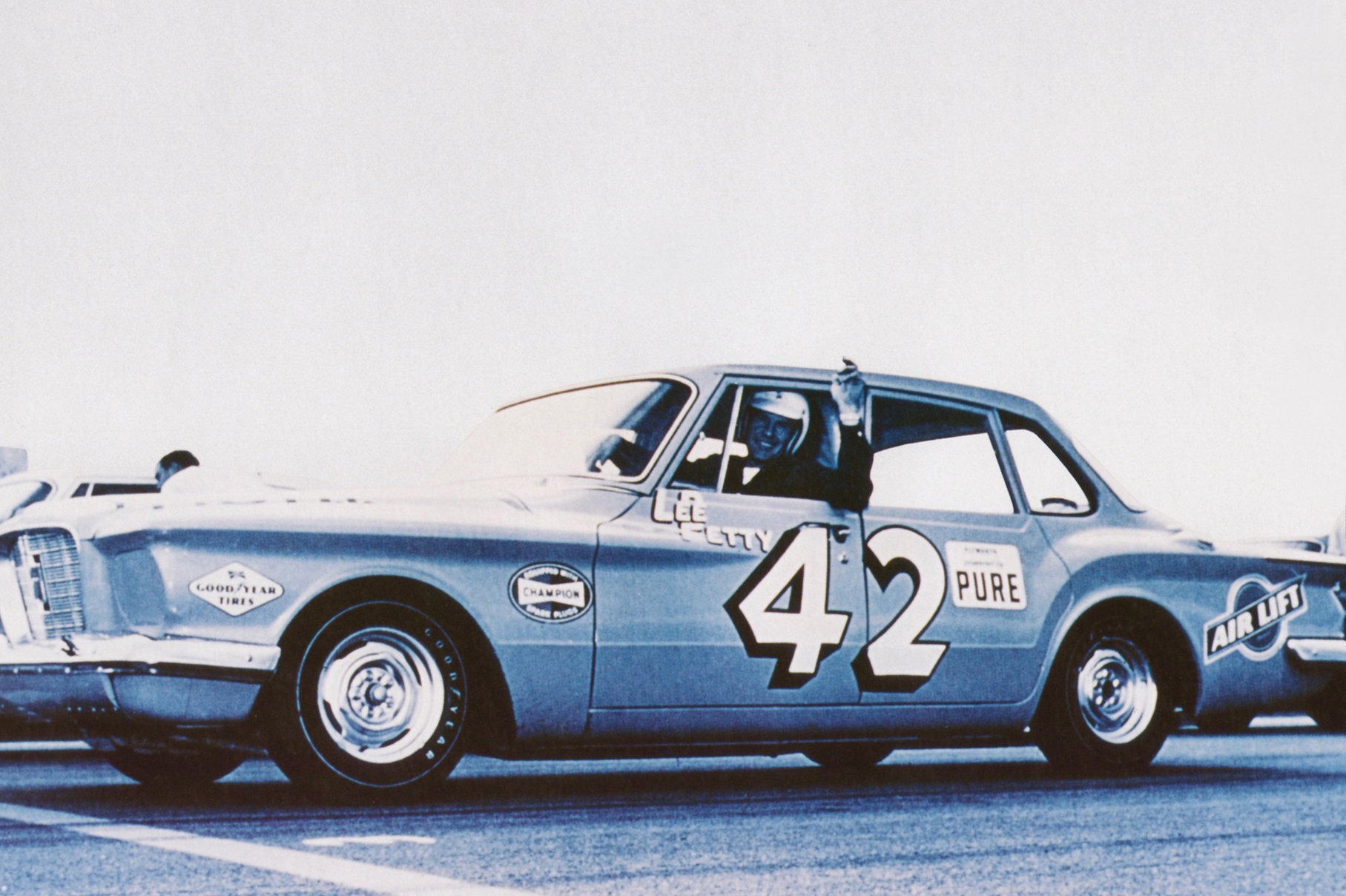
The 1960 NASCAR racing season started out with a new class for compact cars (Chevy Corvair, Ford Falcon, Plymouth Valiant), a race on the Daytona 3.1-mile road course, a 10 lapper. The Plymouth Valiant was dominate (taking 1-7 positions) thanks to the 140-horsepower Hyper-Pack Slant Six engine! Lee Petty was one of the drivers as he came out of driving retirement to have a little fun with the Petty Blue-hued little car, finishing 6th. CBS televised the special race with commentary from newsman Walter Cronkite, who himself was a sports car enthusiast. Lee Petty did go on to win the third and final Compact Division race in 1961, a 49-lapper.
SAVOY SEDANS FOR ’62 & ’63

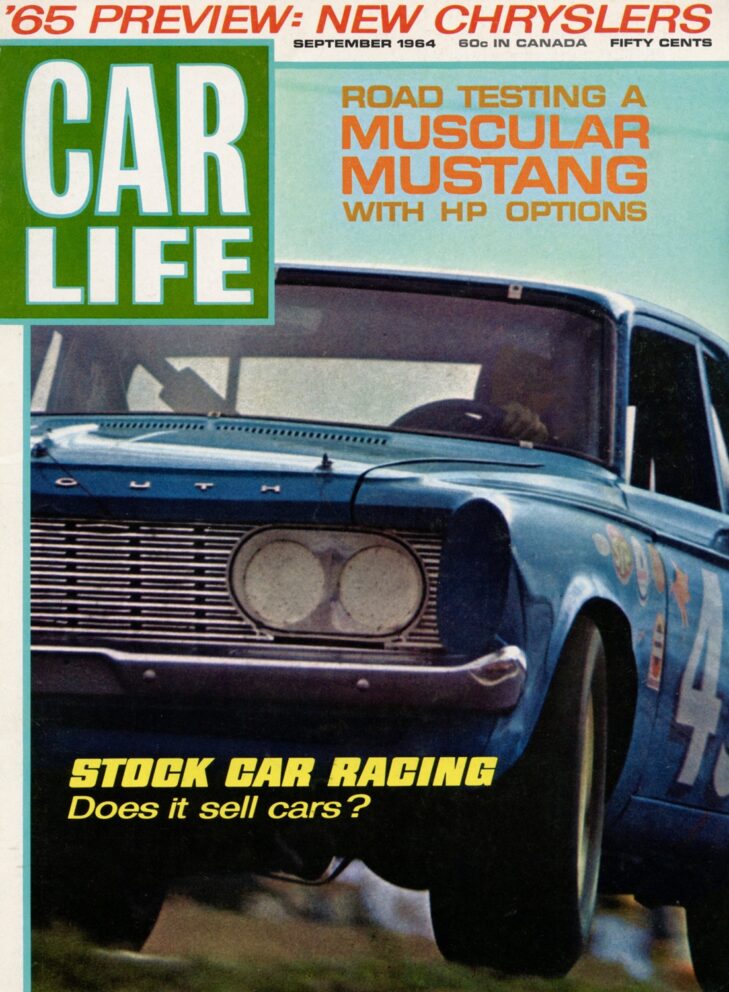
Using the 2-door sedan body, Richard’s ’62 Savoy managed eight Grand National victories, 31 top fives, 38 top tens, which included a 2nd place in the Daytona 500. 413-cid wedge for power. For ’63, a slightly larger 426-cid wedge-head powerplant was used, and said to produce 375 horsepower. Richard improved to winning 14 events, had 30 top-five finishes and 34 top tens. He proved that he knew how to win, just needed some more torque under the hood of that Plymouth.
HEMI® ENGINE FOR RICHARD = WIN FIRST TIME OUT
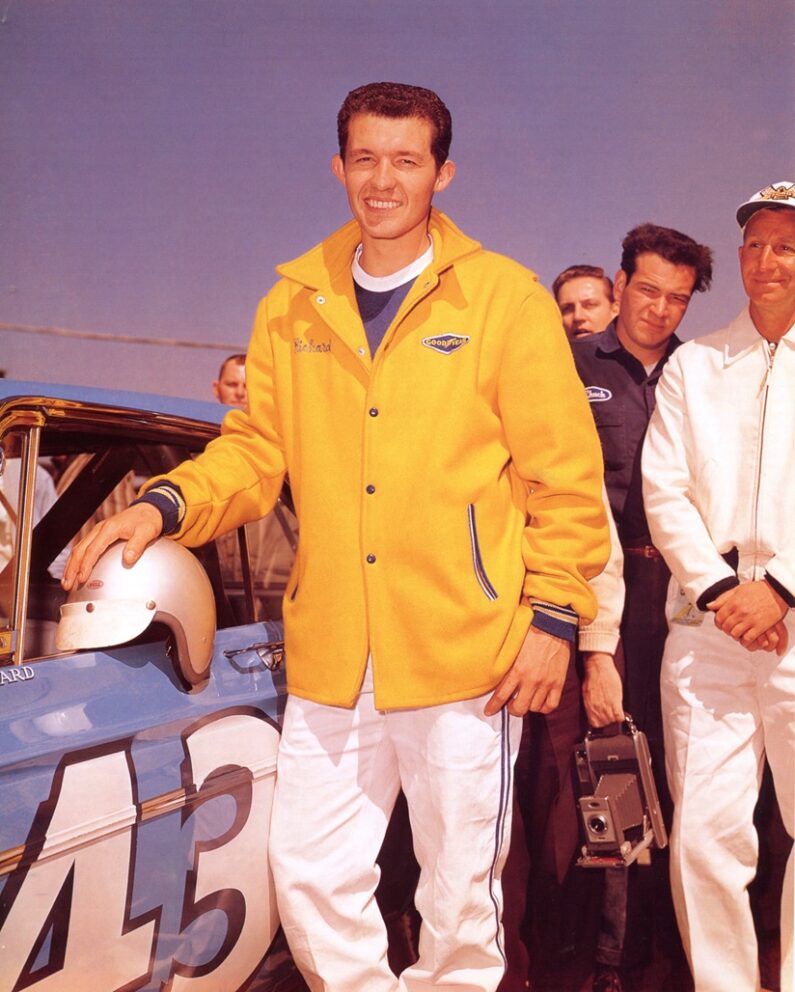
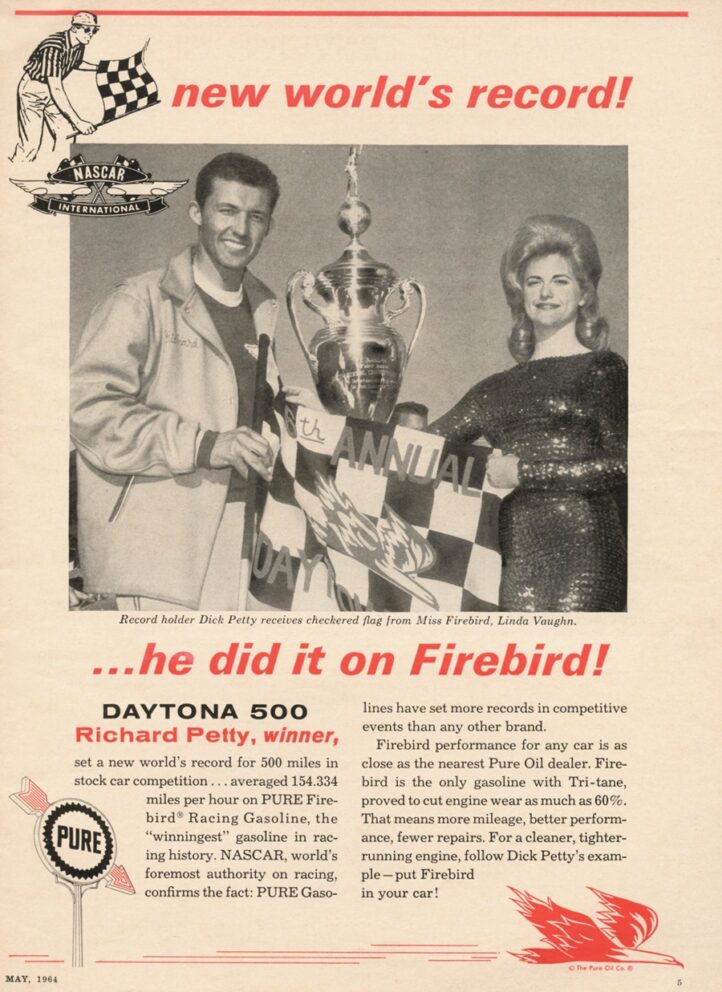
The 1964 Daytona 500 was what really put Richard Petty on the map at the time. Chrysler had just debuted the 426 HEMI engine and the #43 Petty Plymouth dominated the race, leading 174 of the 200 laps! “It was the first time in years that we had the stream to get out there and run on even terms with the other cars. It meant that I no longer had to pull one trick after another out of my sleeve to stay with the front runners,” said Richard in his autobiography book Grand National. “When we got to the track, even I couldn’t believe how strong it was!” He set an all-time record at Daytona with an average speed during the race of 154.334 mph.
He went on to win the season points championship and total winnings were $114,771.00. That HEMI engine performed so well that NASCAR effectively banned it the following season, forcing Petty to boycott stock car racing as that is what his boss at Chrysler mandated.
43 Jr.
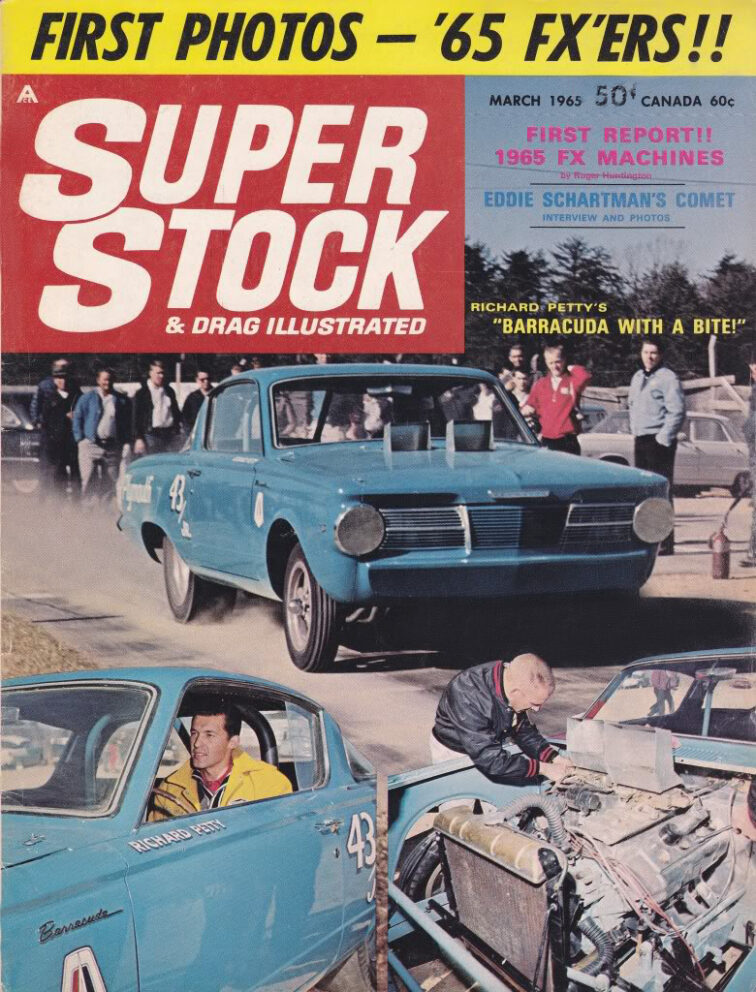
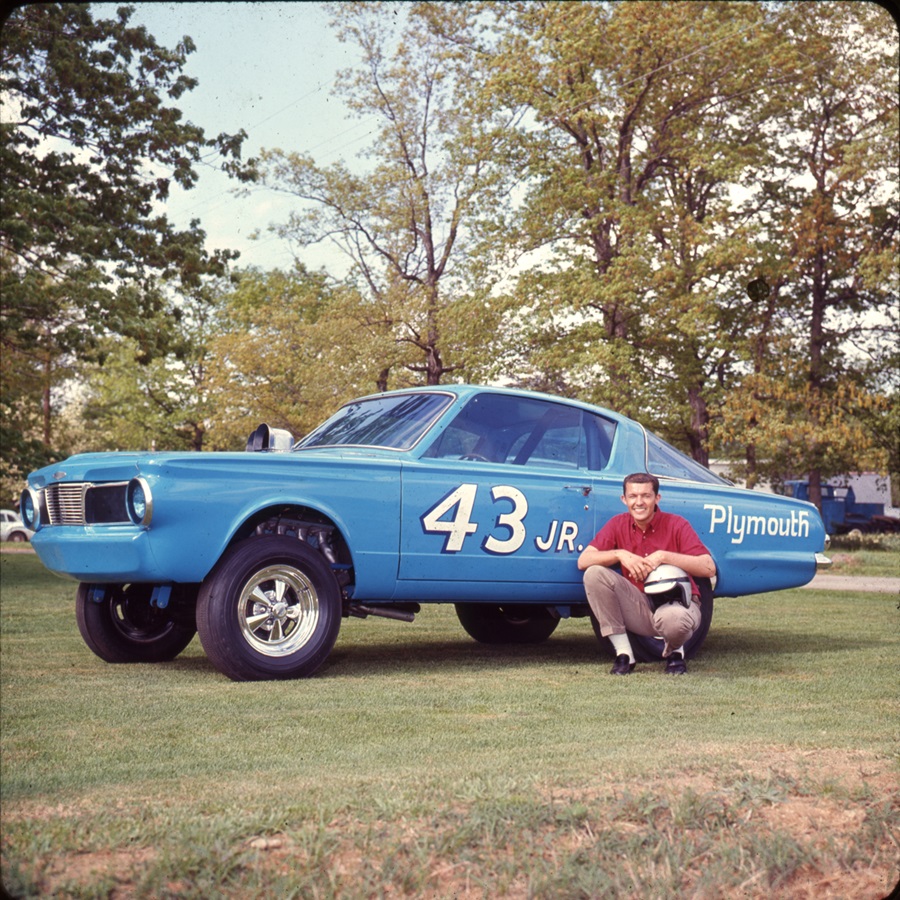
Due to a conflict of the rules for Grand National cars that Chrysler had with NASCAR, in 1965 Petty Enterprises built a drag race Barracuda that was powered by a 426 HEMI engine (first on carburetors, then in injectors), TorqueFlite® transmission and reworked suspension. There were two cars built, the first one was involved in a terrible mishap where a part on steering broke and the car went out of control into a crowd at a drag strip, without any brakes, killing an 8-year-old boy and causing injury to 6 other people. Richard was disenchanted with drag racing after that and although another “43 Jr.” car was built, his heart just was never into driving drag cars anymore. Years later, Petty Enterprises built a Plymouth Duster Pro Stock car for Roy Hill from nearby High Point, North Carolina.
BACK TO A BELVEDERE FOR ’66
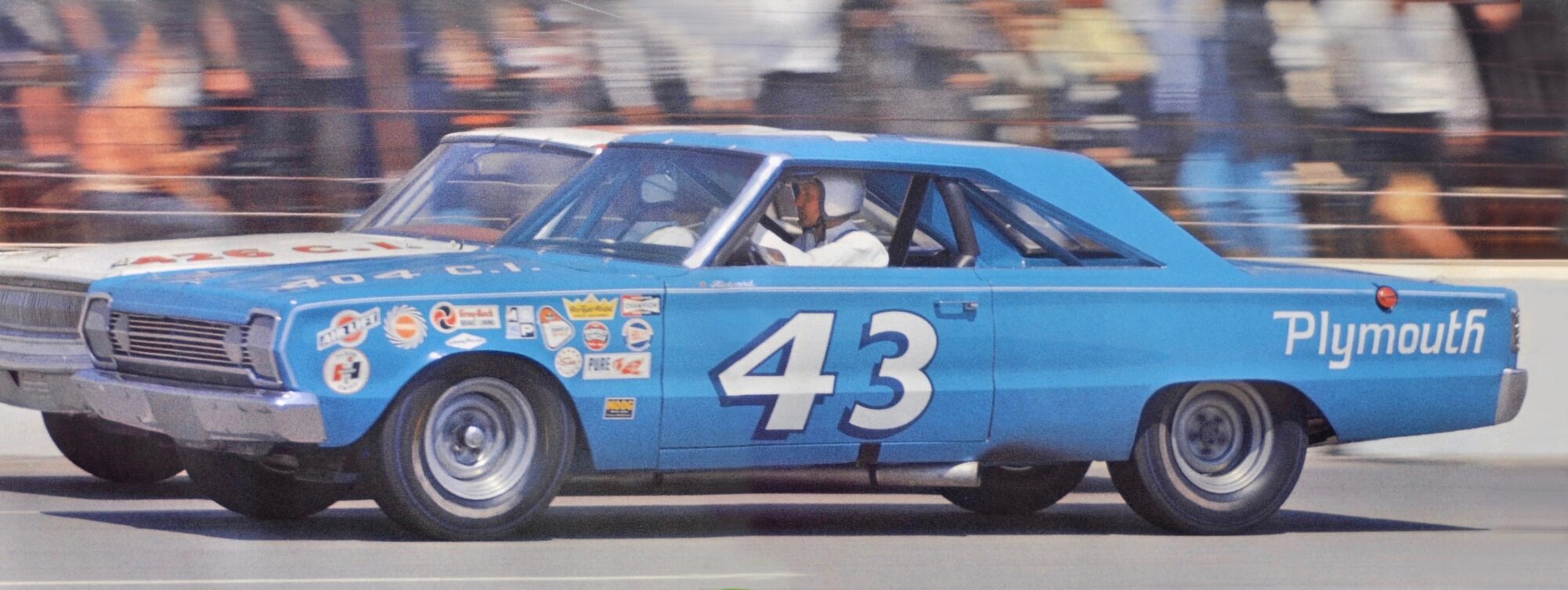
The Petty team incorporated the newly style Belvedere body in their 1966 racing campaign, and they returned with HEMI engine power, and his powerful Plymouth earned some 19 pole positions.
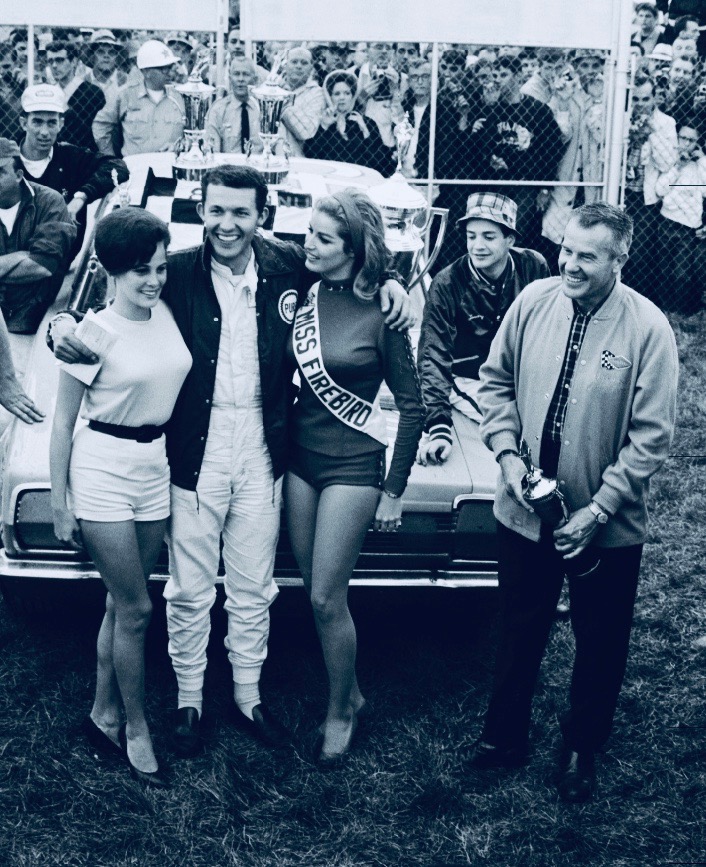
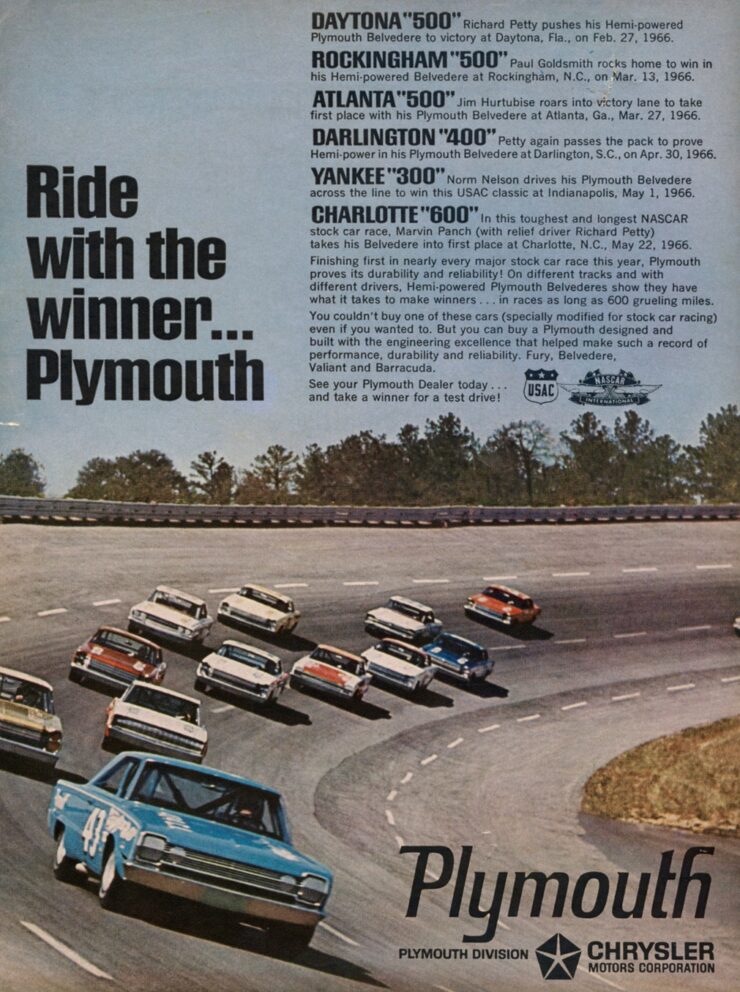
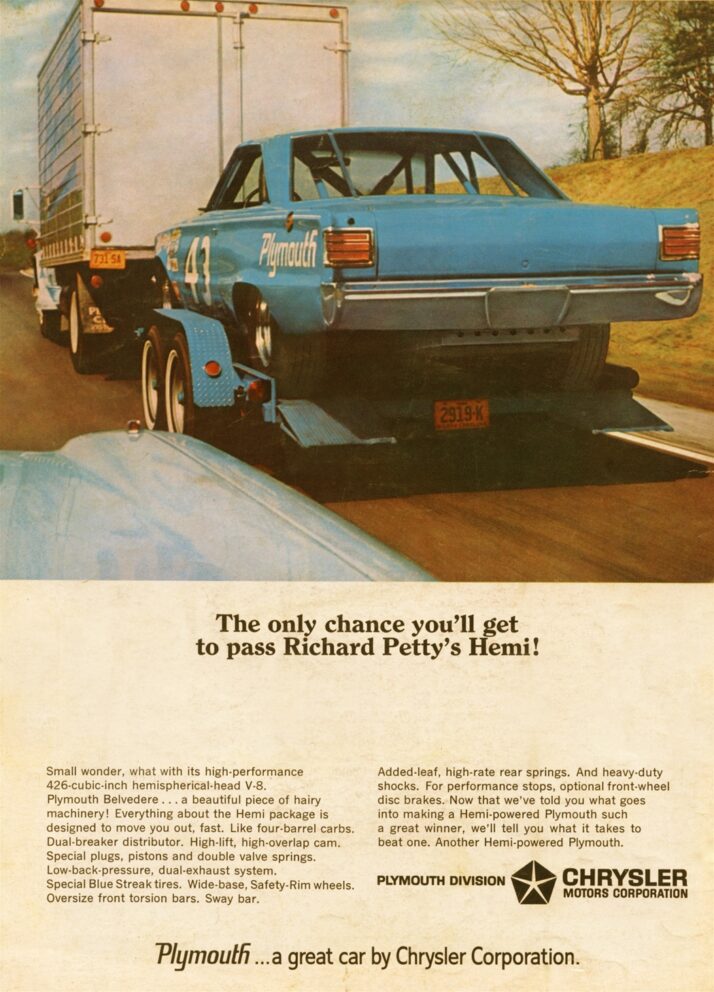
That 1966 season saw Petty with a de-stroked 404-cid version of the HEMI engine under the hood, he went out and won the Daytona 500 that year as well, the only person at the time to ever accomplish winning the prestigious race more than once. The NASCAR rules in 1966 stipulated that the HEMI engine could not be larger than 405-cid when racing on tracks one mile or longer, however the superior hemispherical-shaped combustion chamber design worked so well that it didn’t matter if there were 22 less cubic inches! This was the start of an era where when Richard Petty showed up at a race track, track-side observers would ask, “Who’s going to run second?”
DREAM SEASON 1967
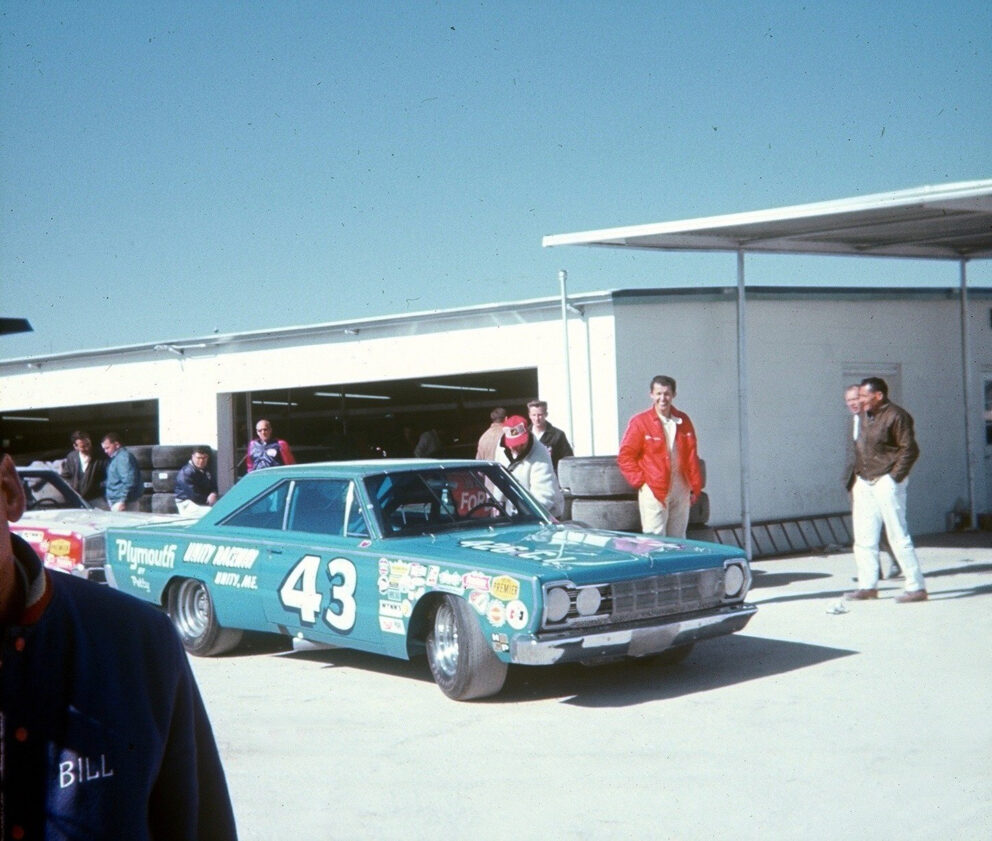
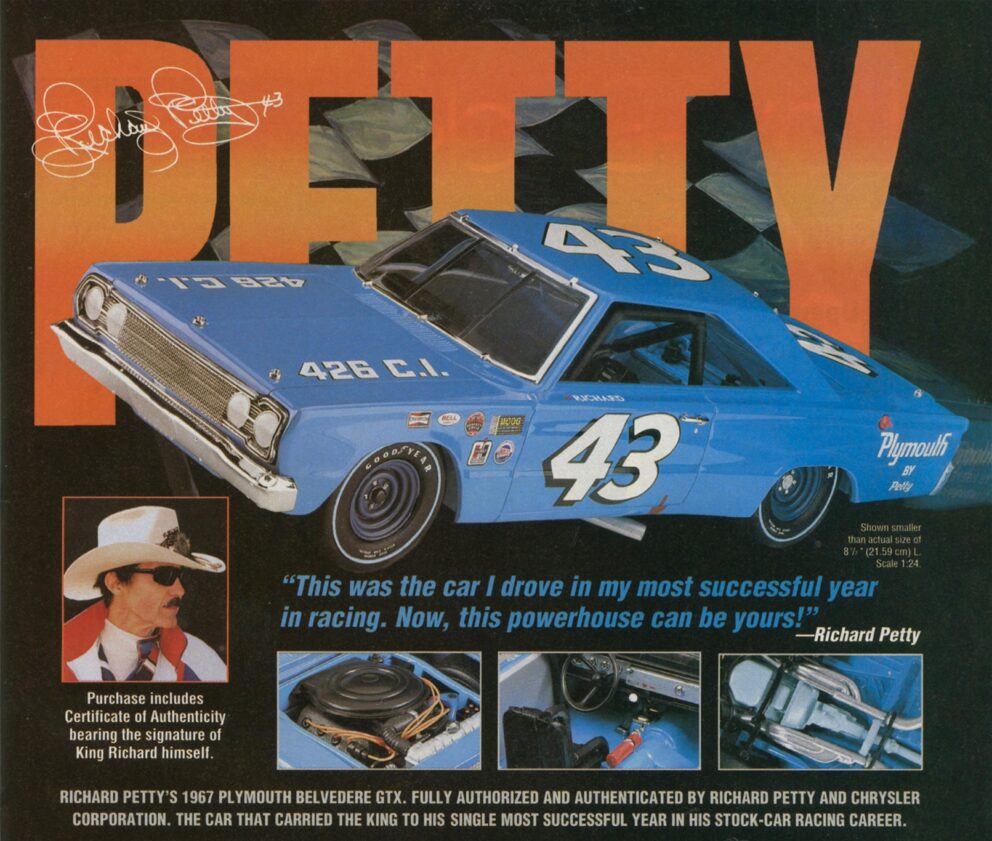
An example of Richard’s “never give up attitude” was at a race in Nashville during 1967 where he was leading, and then blew a tire and crashed into the fence at turn three, knocking out the front alignment and taking the left rear spring out. The car limped into the pits and Maurice told his brothers to “just park it over there.” Richard quickly protested. “Heck no, let’s try and get it back out there and see what’s going on.” With eight or ten laps down time in the pits doing the welding and hammering to repair the crumpled-up Plymouth, four fresh tires were put on, then Richard again raced out to the track.
He was the fastest on the track, and he kept on pushing hard and soon reached fifth place by the time the race was three-quarters over. Then the leaders started falling out of the race and by the time the checkered flag dropped, the #43 car had a five-lap lead on 2nd place and won the event!
“The ’67 Belvedere was a special car,” remembers The King. “Back then, we usually found a car that was good on the short tracks or speedways or dirt tracks, but not many that were good everywhere. That Plymouth was fast no matter where we ran.”
The car was actually a ’66 model that was updated with a new grille through the 1967 racing season. “Just finishing 10 races in a row would have been a big deal,” recalled Richard. “Let alone winning 10 straight and more than half of the races at big and little tracks all over the country. It had to be the season for all seasons for anybody in any sport.”
With winning the championship along with the $132,000.00 in prize money (a lot in 1967 dollars!), the car that accomplished all that was forever remembered in 1:24 scale and was marketed in 1996 from Franklin Mint (5 payments X $24.00). Now those diecast cars are hard to find!
CHEATED UP ’68 ROAD RUNNER
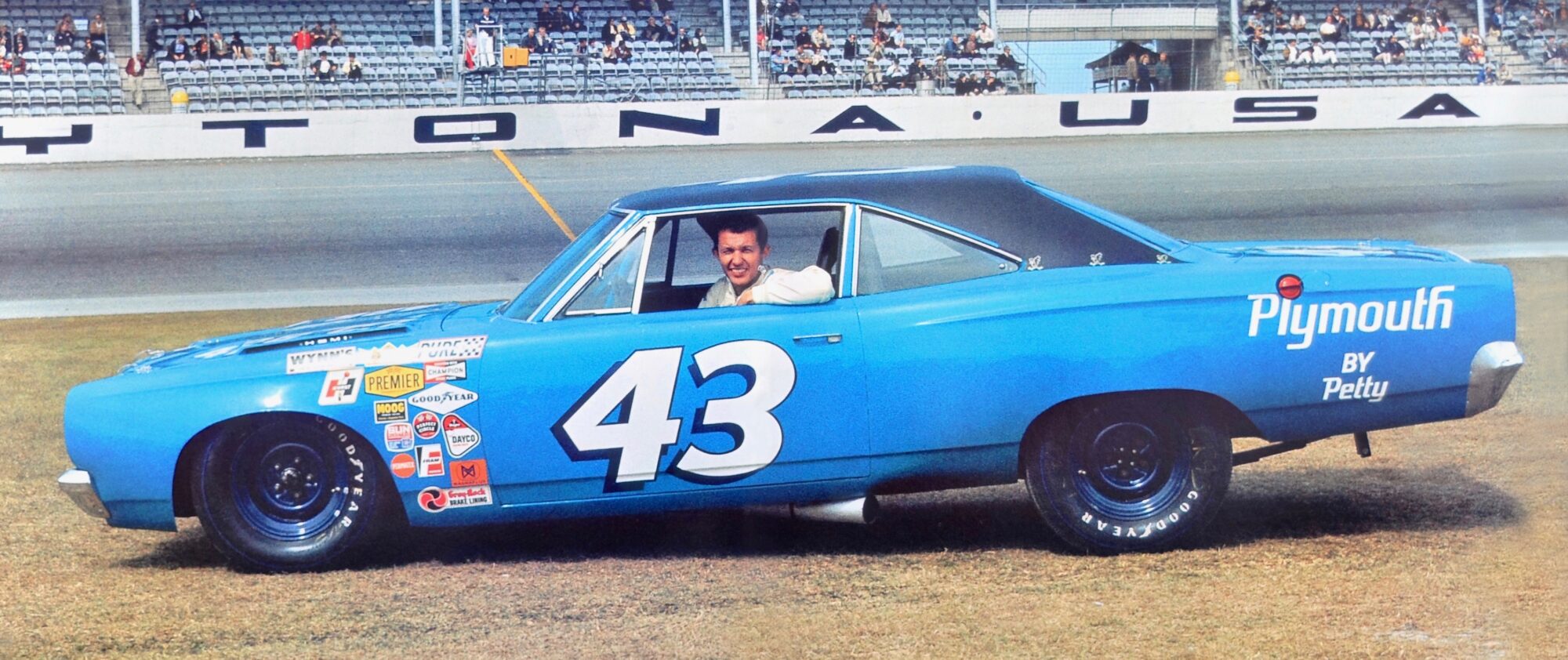
The 1968 car, with its textured black painted top, as it is getting time for the Daytona 500. “The paint was a wild idea that helped some aerodynamically, although we didn’t go to the wind tunnel in those days,” recalled Richard. “But it was more of a decoy than anything else. The car was so cheated up with body modifications that we figured (correctly) that NASCAR’s inspectors would concentrate on the top and not check the rest closely. It was the most illegal car we ever took to a race.”
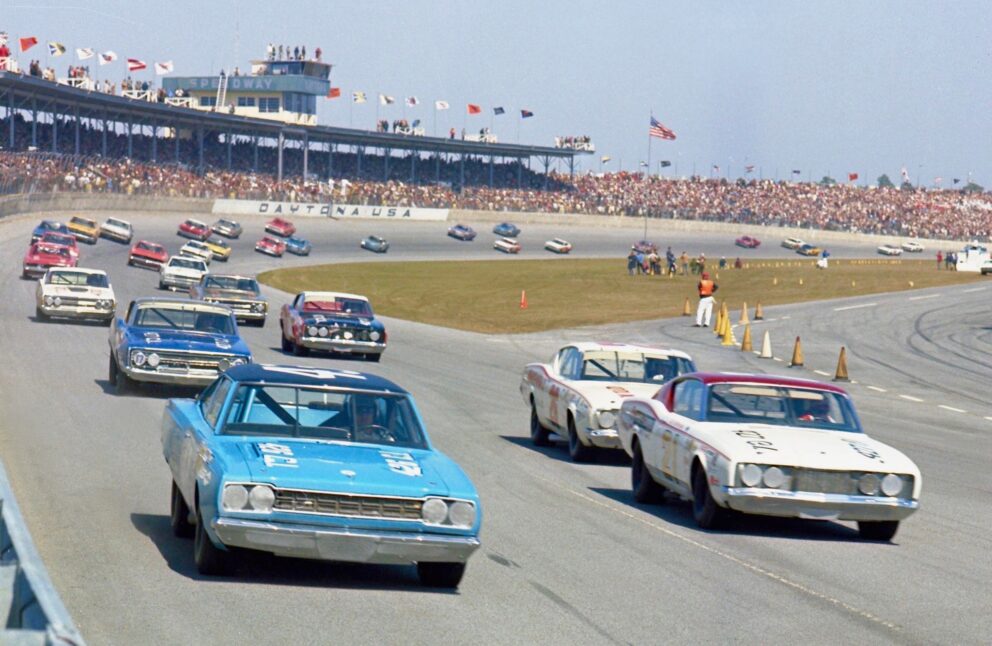
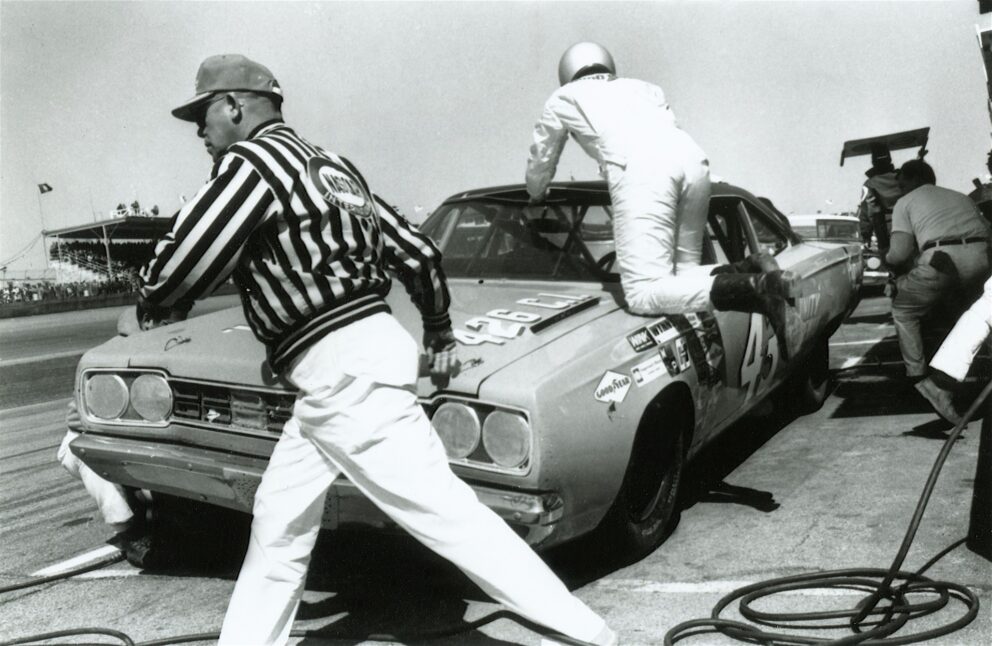
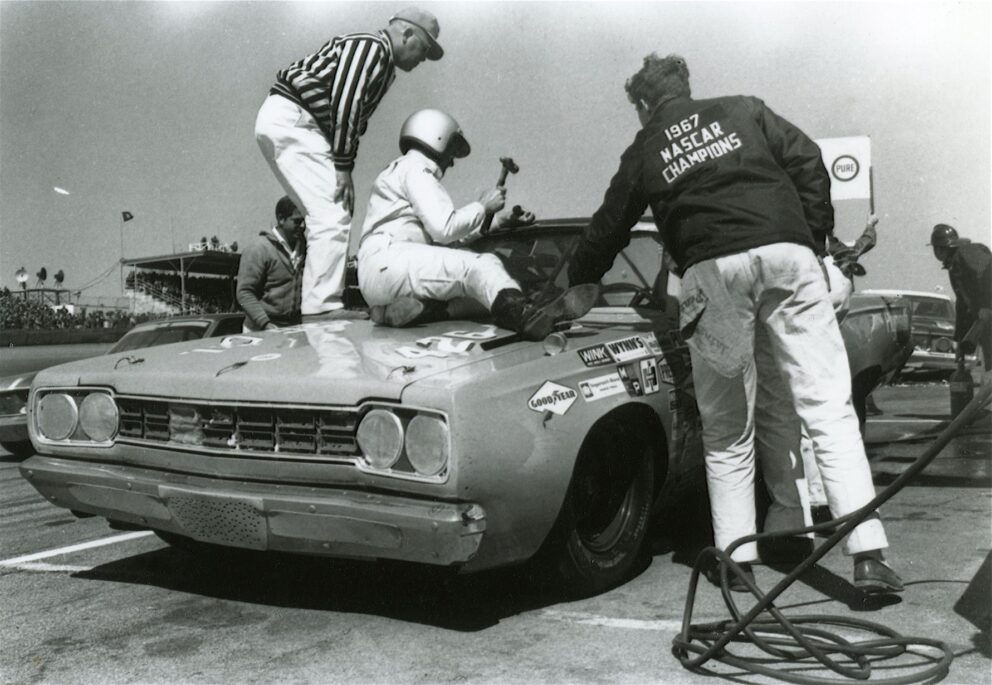
While leading the race, Richard could hear a mysterious whistling sound inside the car, and within laps, the metal roof panel (which wasn’t properly welded) began to separate from the windshield frame. Once the car came in for the pit stop, Richard himself climbed out of the car and started beating in the roof and then the duct tape was applied, a lot of time was lost, causing him to go down two laps, and an 8th place finish. Overall, Richard won 16 races and was third in season points.
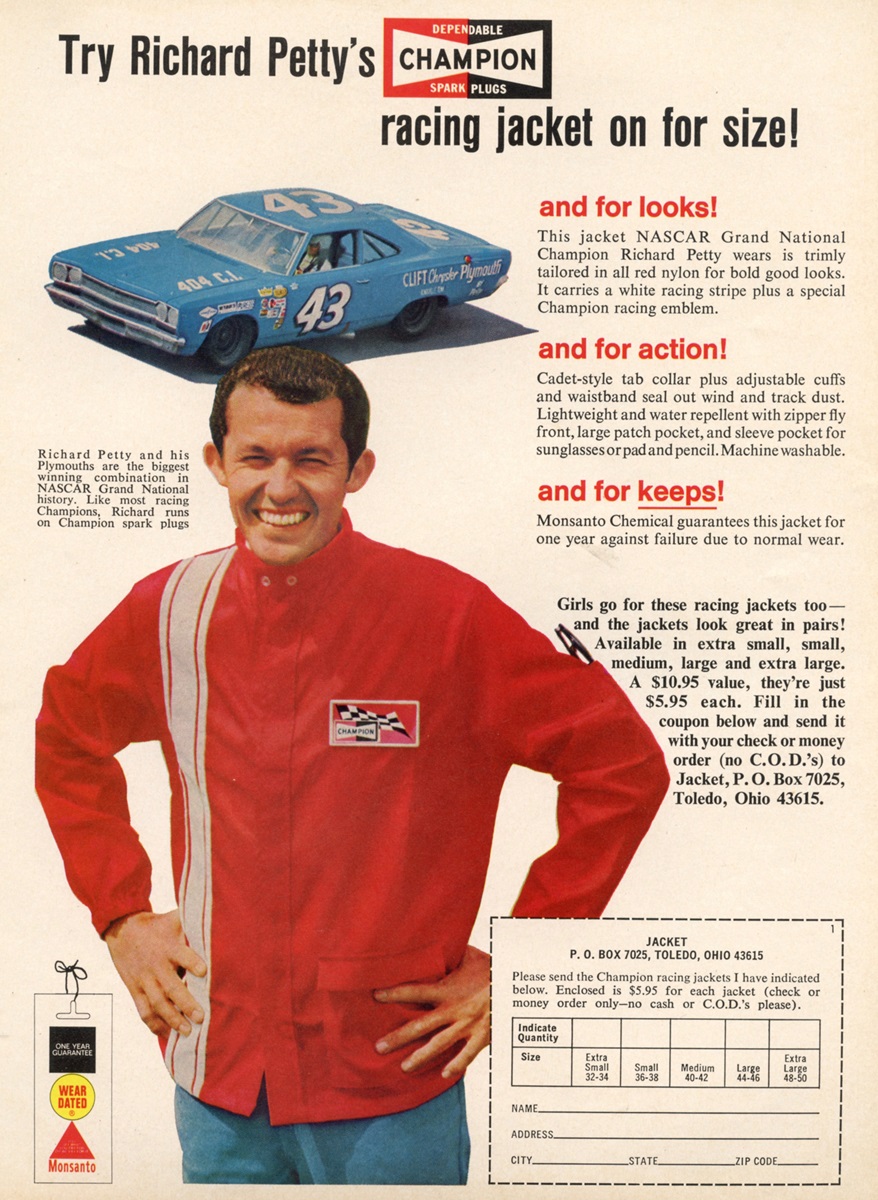
Champion Spark Plugs featured Richard and his ’68 Plymouth (now without a black top) and it all seemed to be good; however, things were about to change for Petty and for Plymouth as he made the move to Ford for ’69. Why? Richard got wind that a special aerodynamic version of the Dodge Charger was being readied for competition for 1969 season, and Petty asked for one, was told NO, because he was a Plymouth guy. So when Dearborn welcomed in Petty for ’69, it happened.
SUPERBIRD ARRIVED FOR 1970

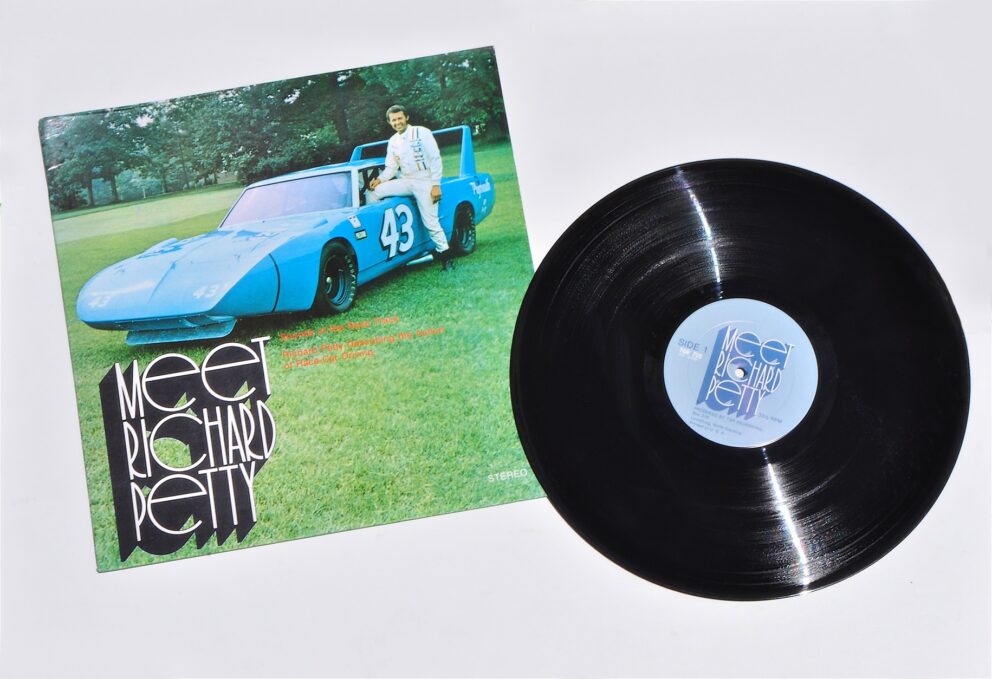
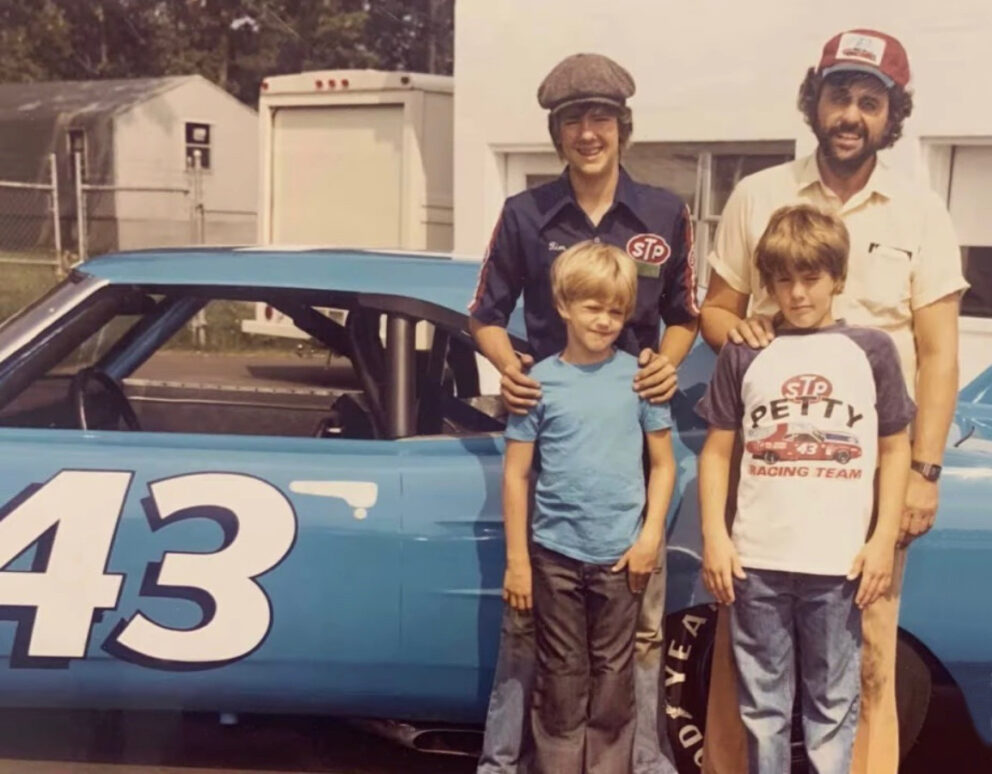
On December 17, 1969, Petty Enterprises announced that they had returned to Chrysler and would be campaigning a new 1970 Superbird model. On the same day, ABC Television released information that they had reached a deal with NASCAR where the network would televise six races during the season, which greatly helped gain exposure for stock car racing in general. The timing proved to be perfect for Plymouth getting back in the sport! Brother Maurice and his three sons (Timmy, Mark and Richie) posing back in the era with the #43 Superbird.
In 1970, TGR Recordings came out with a double-sided stereo record album of Richard describing the action of racecar driving, and today these vinyls are becoming scarce and are highly valued amongst serious Richard Petty memorabilia collectors.
Here’s how Richard remembers the day, while he was running the Ford in 1969, that he was visited by the top guy at Plymouth. “He said, ‘OK, what would it take to get you back with Chrysler?’ I said, get me a Dodge. He said, ‘No. We can’t get you a Dodge.’ I said, well, get me a Plymouth a put a wing on it. He said ‘OK. That’s what we’ll do.'”
ENTER PETTY TEAMMATE PETE HAMILTON
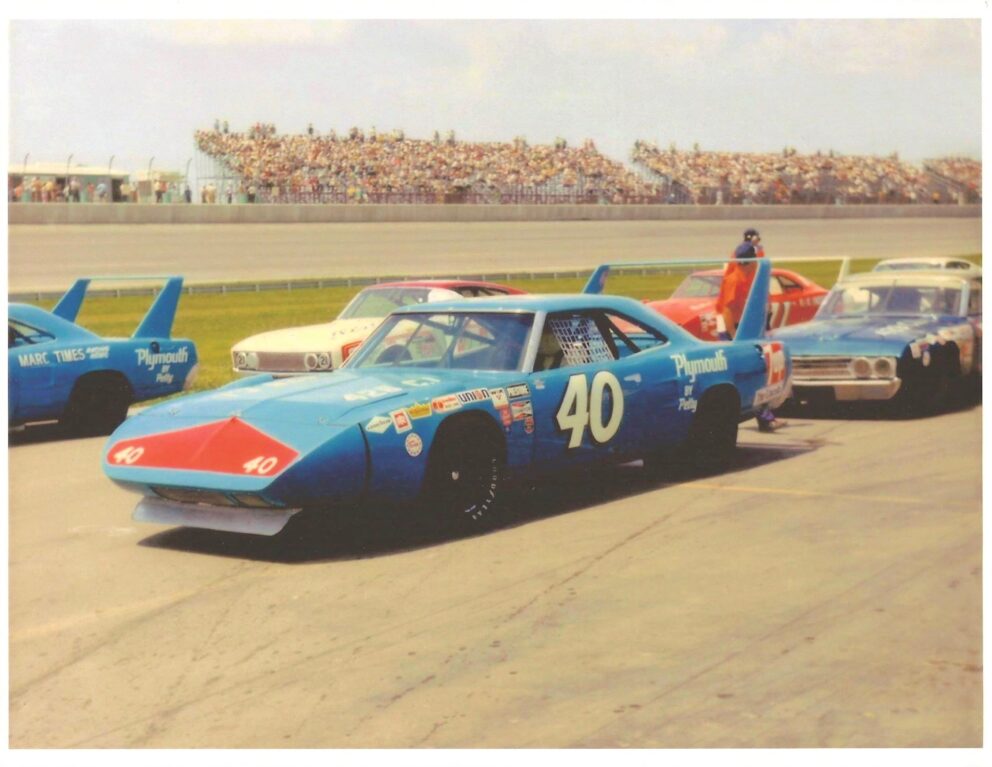
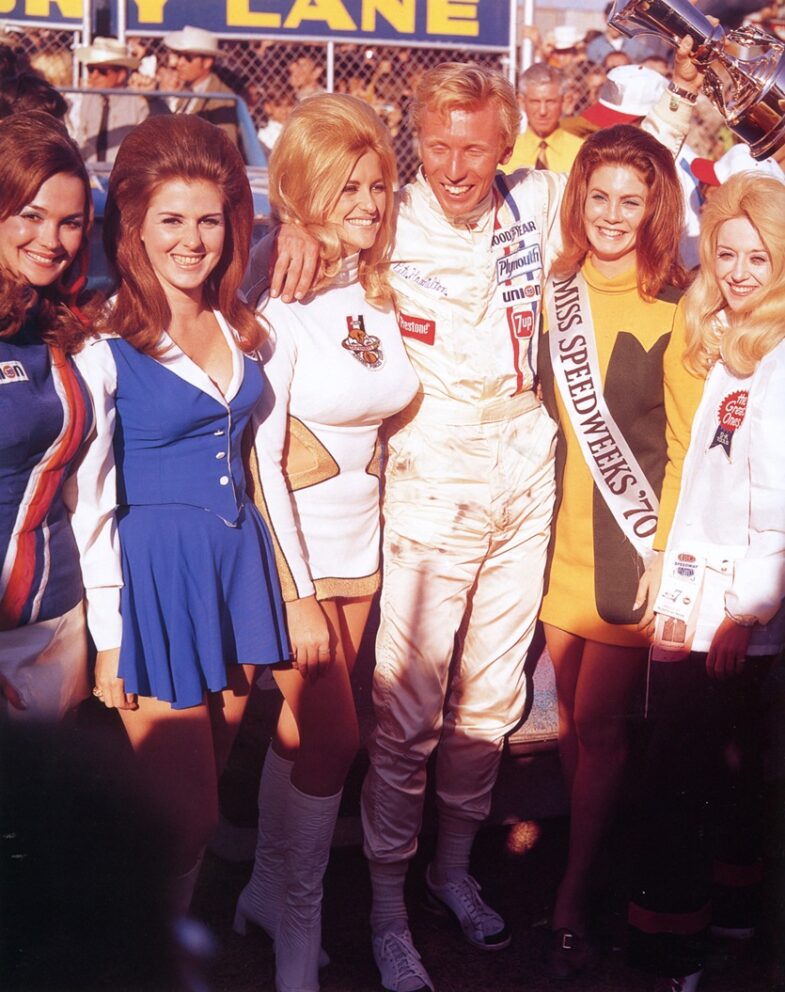
Richard Petty didn’t win the Daytona 500 in 1970 with the new Superbird, but the Petty team car did, Pete Hamilton’s #40 entry was the winner! Here’s Pete with Hurst’s Linda Vaughn, Miss Speedweeks ’70, the Union 76 Show Stoppers, and the S-K Tools trophy presenter. Later in the year, he led 153 of the 188 laps at Talladega, and most importantly, the very last lap! The New England driver also won the second Talladega super speedway event in the team car, with ten top-ten finishes in all that year with sixteen starts. The nose was painted red to help the Petty crew quickly differentiate it from Richard’s car as they came rolling into the pits.
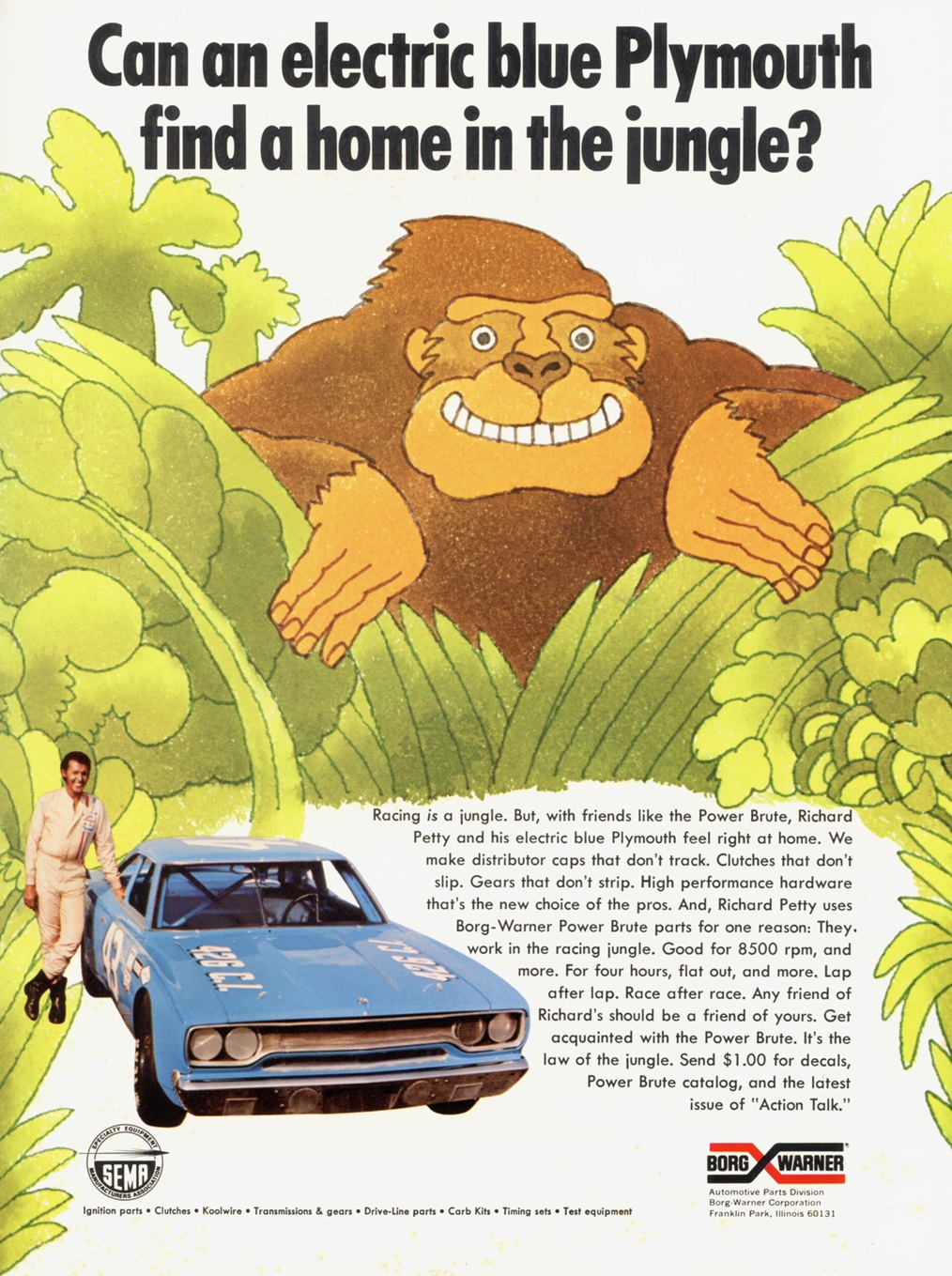
Even though the Superbirds were grabbing a lot of attention throughout the NASCAR season, there was a regular Roadrunner that ran on the short tracks.
1971: NO MORE WINGS
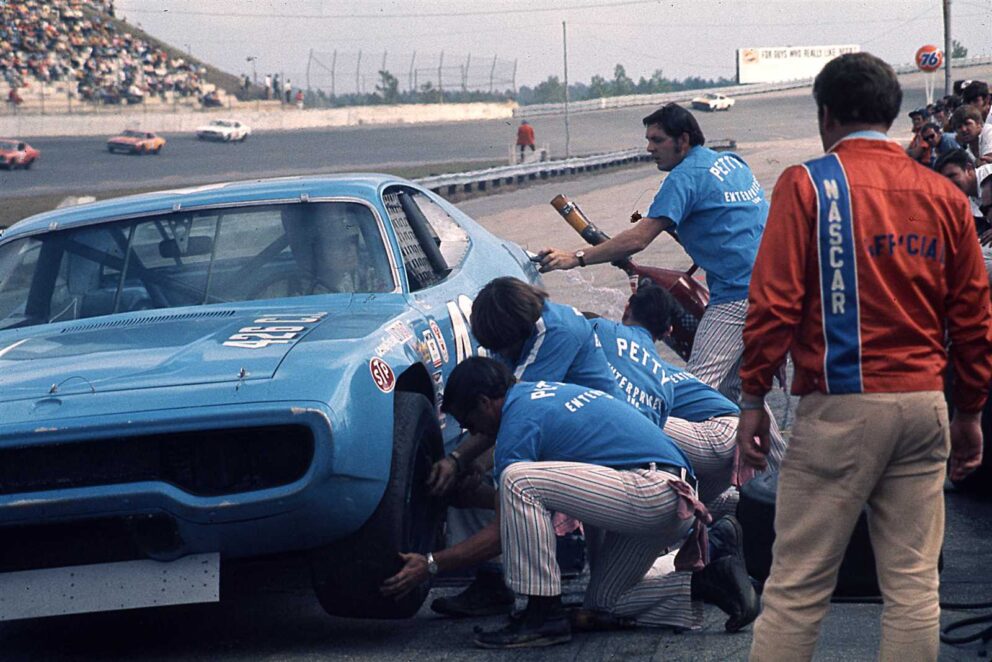
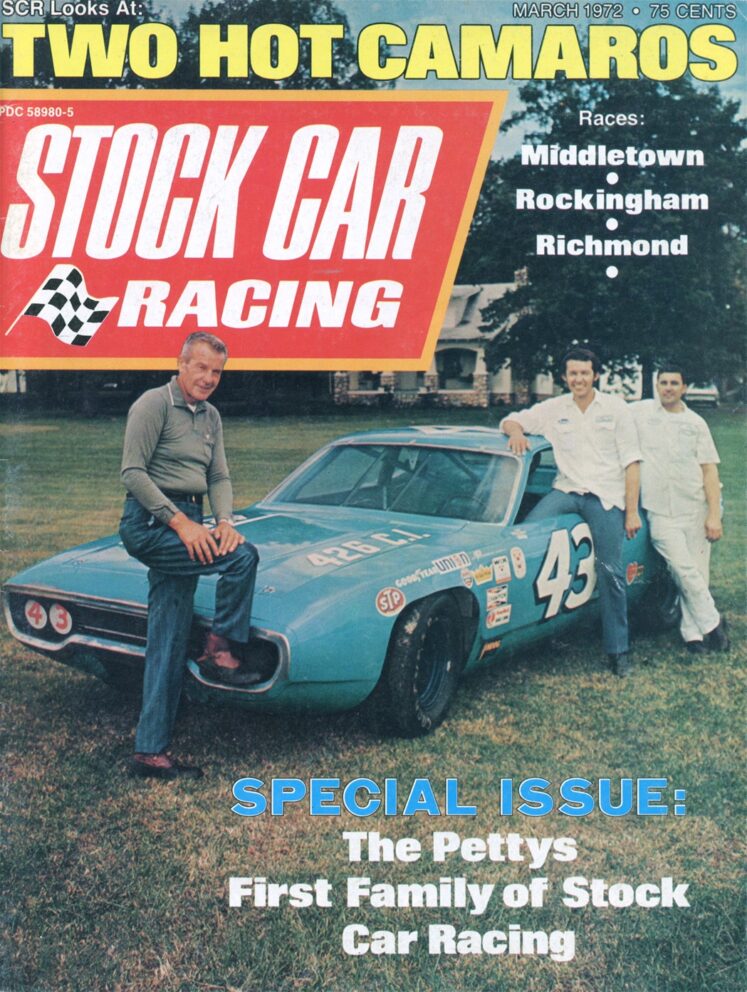
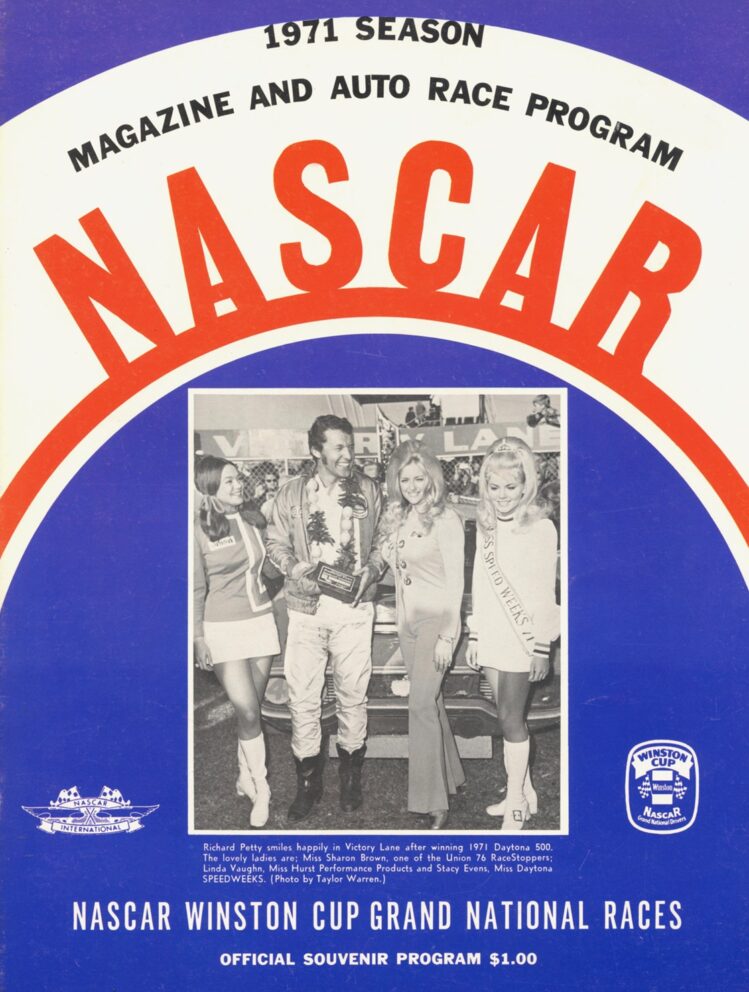
For their March 1972 issue, Stock Car Racing Magazine dedicated a large portion of the publication to telling all about the Petty family, as shown on the cover with father Lee, left, Richard (center) and brother Maurice with the previous 1971 Road Runner car that won the championship in ’71.
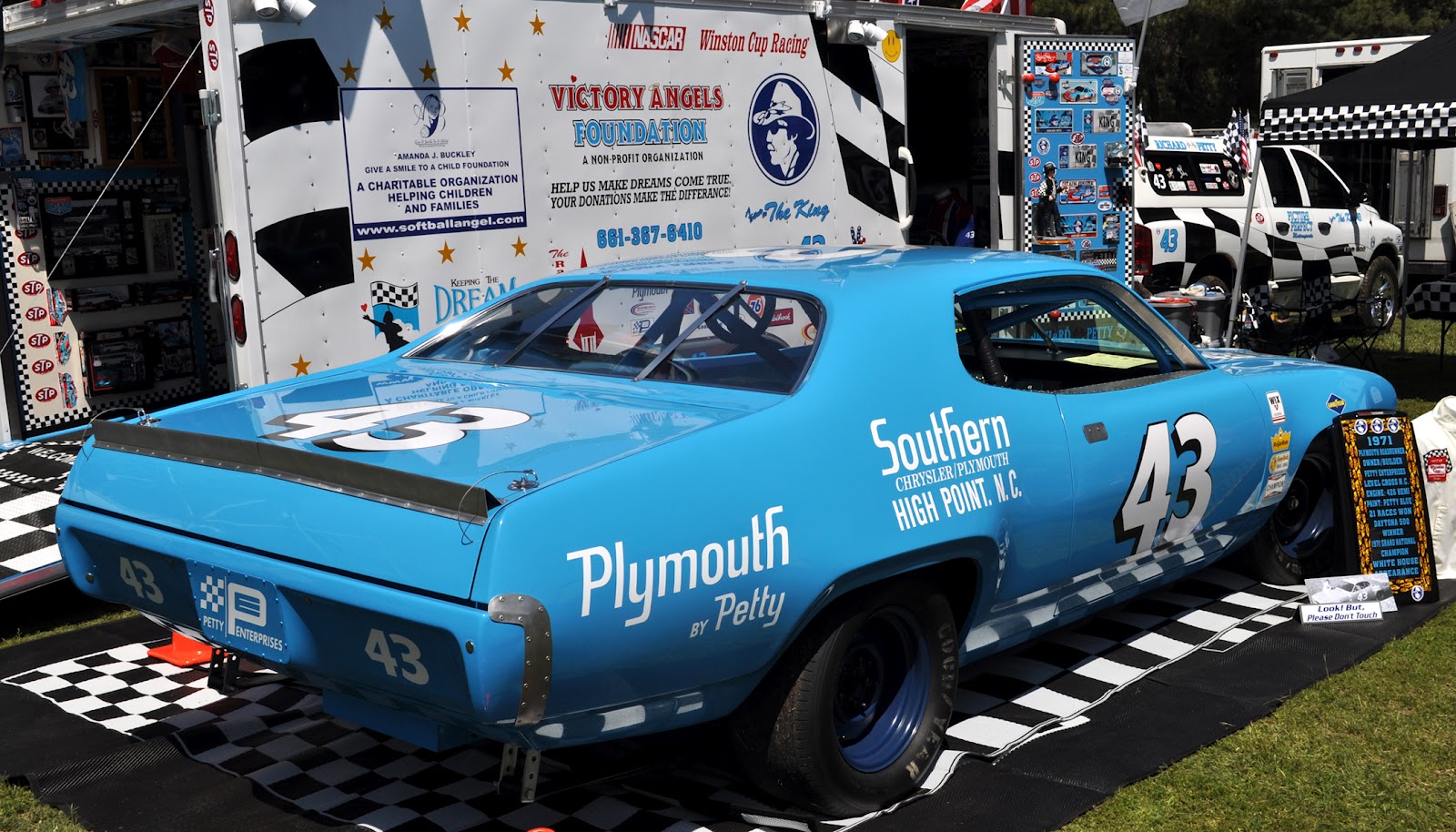
An accurately restored 1971 Petty car makes the car show tour, celebrating its 21 victories, including the Daytona 500. It also won the Winston points championship.
ENTER ANDY GRANATELLI AND STP
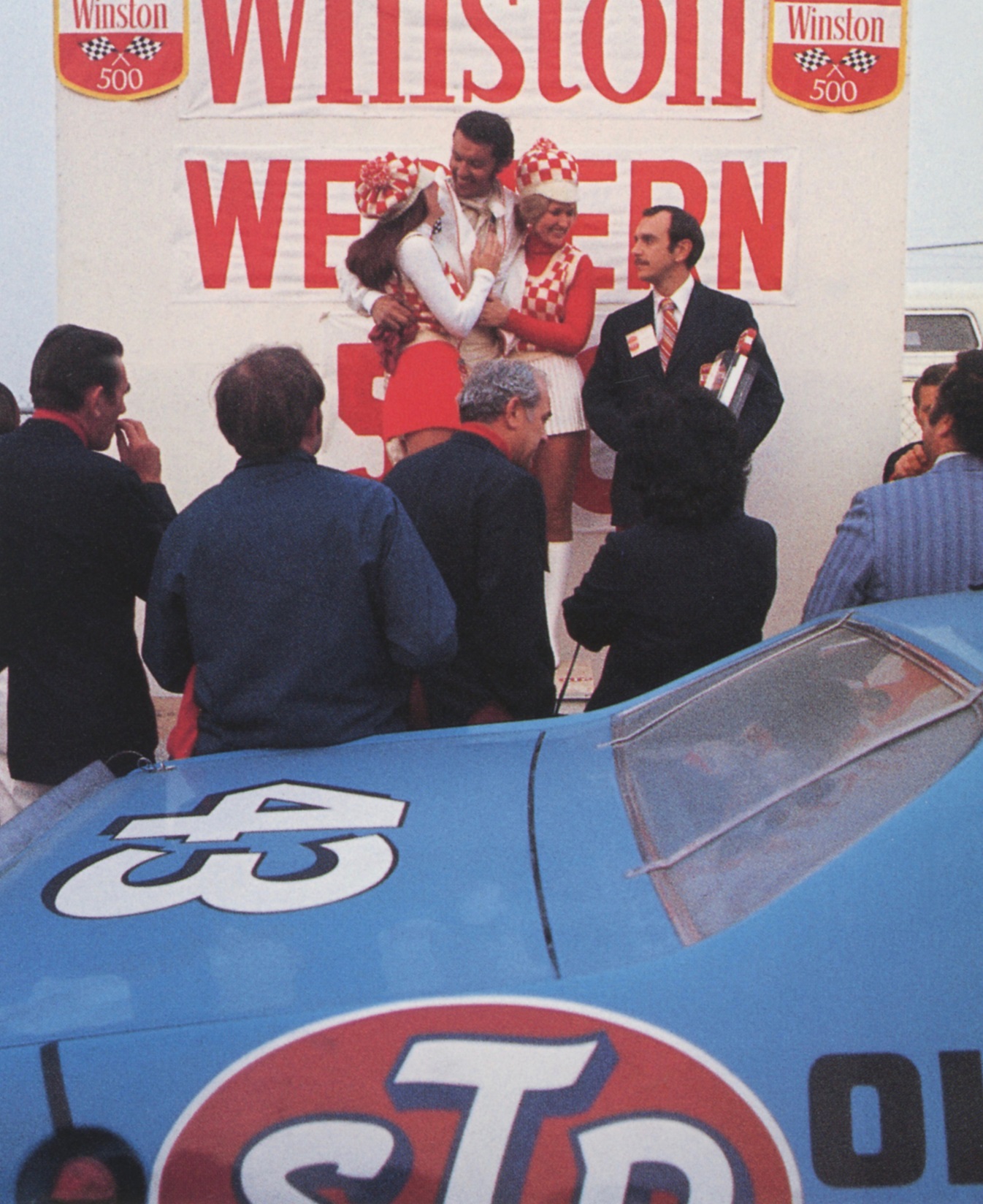
“In November of 1971, this guy walked into our pit area and introduced himself. It was Andy Granatelli, the president of STP. I didn’t think much about it. Then he called one day and asked us to come to Chicago. Flying to Chicago one day in 1972, on my way to a race at Riverside International Raceway, I never would have thought that I would soon be forming an alliance with a company that would last a quarter of a century,” recalls Richard Petty. Because the factory was withdrawing from full support funding-wise at this time, the Petty team really needed to land a sponsor to make up the difference in dollars.
There was a major topic of debate, however, during that meeting and it all revolved around what color the Petty Plymouth was going to be. “I was stubborn and argued to keep it blue,” Richard had told Circle Track Magazine. “I told Andy nobody would know Richard Petty in a red car and he countered that nobody know STP in blue. When I got the contract, there was a clause offering $50,000 extra to paint the cars red. I declined.
There was no time to do any painting for Riverside, so the car had huge STP markings on the quarter panels of the Plymouth for that race, and Richard won. Granatelli was in Victory Lane with the Petty team and that sponsorship was a huge plus for all parties. By the next race (the Daytona 500), a special paint scheme was designed to showcase both the Petty Blue and STP Red colors, and that combination of hues became the most famous combination of colors in NASCAR history. The sponsorship lasted 21 years in all.
PETTY AND THE KIT CARS
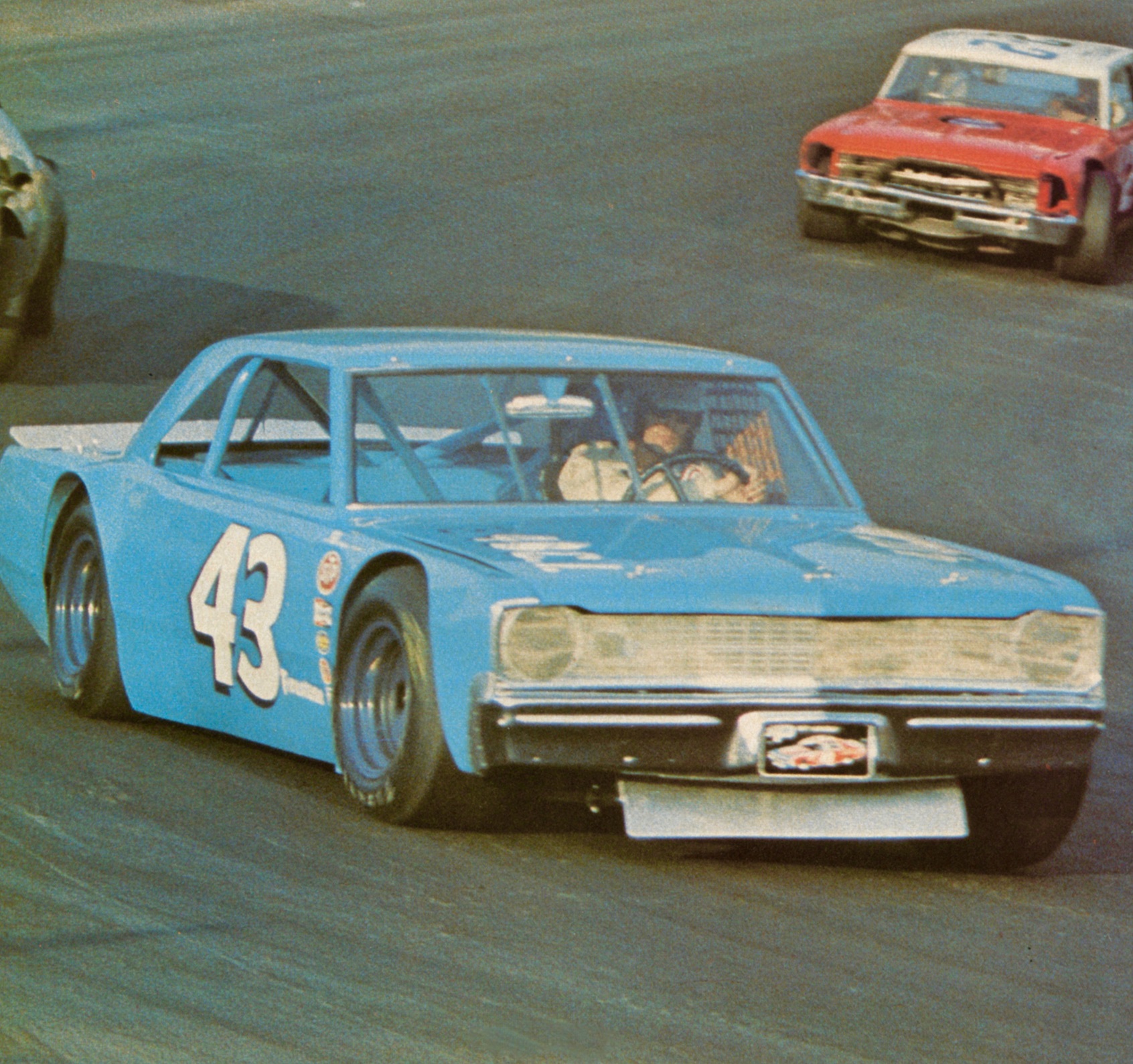
In 1973, Chrysler came out with a new concept called the Kit Car where race customers could buy all the components to build what became known as “Saturday Night Specials.” The factory sent down an engineer to Level Cross and the guy (named Larry Rathgeb) did all the design work, and Petty Engineering manufactured all the parts and handled the shipping. Richard did the testing on the car with an A-Body Dodge Dart (Duster/Sport shown) and Pete Hamilton tested the E-Body Dodge Challenger version. The basic kit was priced at $2,795.00, completed cars were $9,995.00.
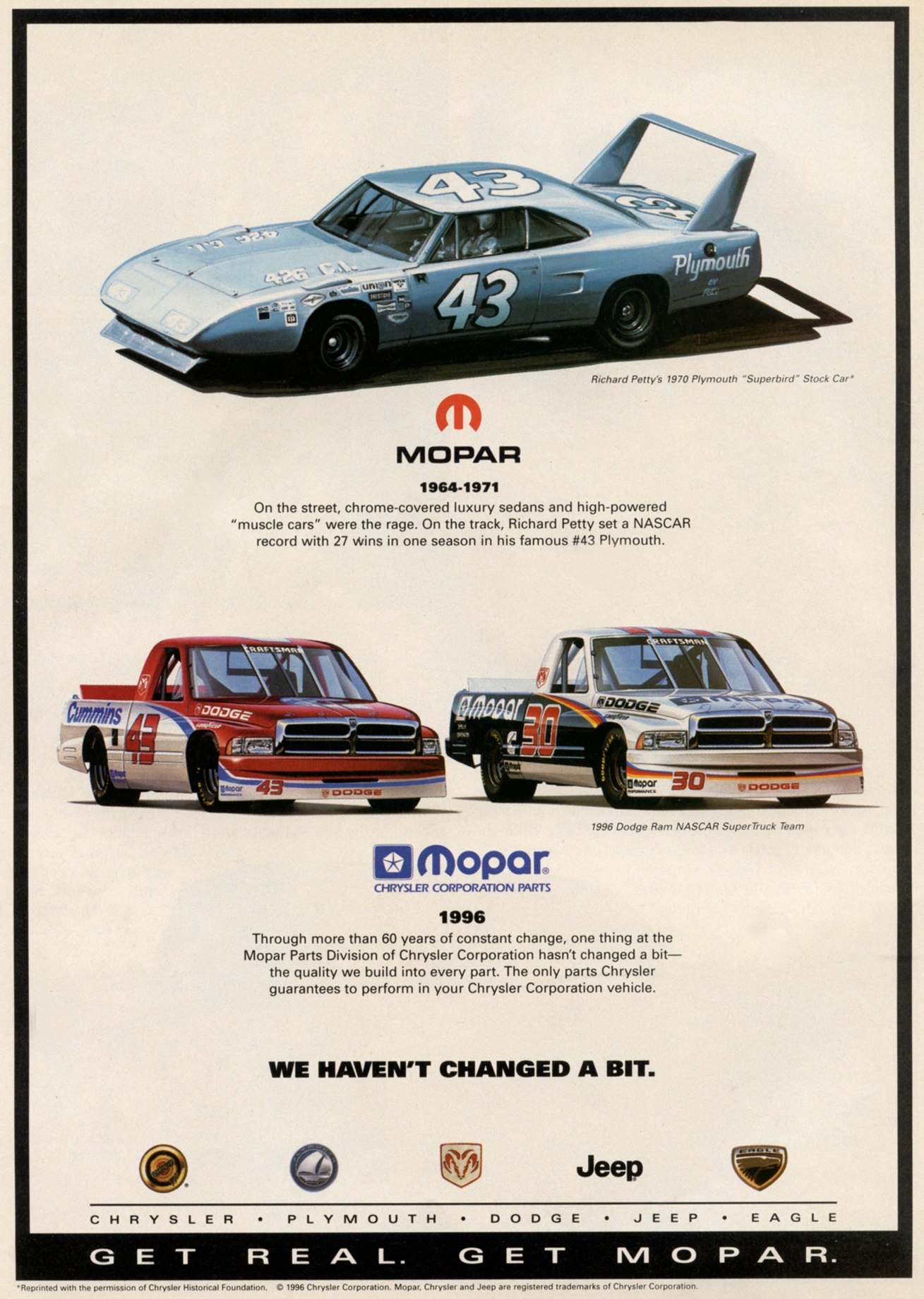
In this “Get Real. Get Mopar.” 1996 Mopar Parts ad, Richard Petty’s Superbird as well as the #43 Petty Dodge Ram Craftsman truck were featured.
DIECAST SUPERBIRDS
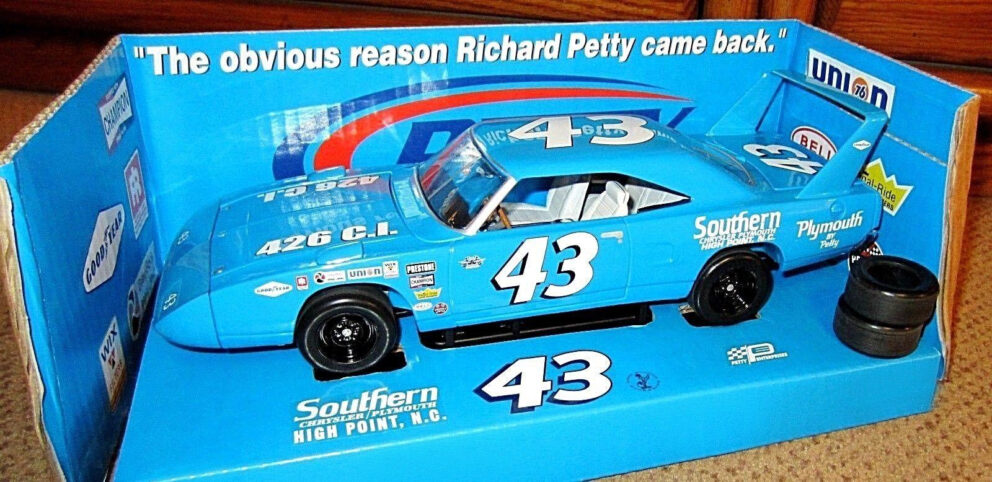
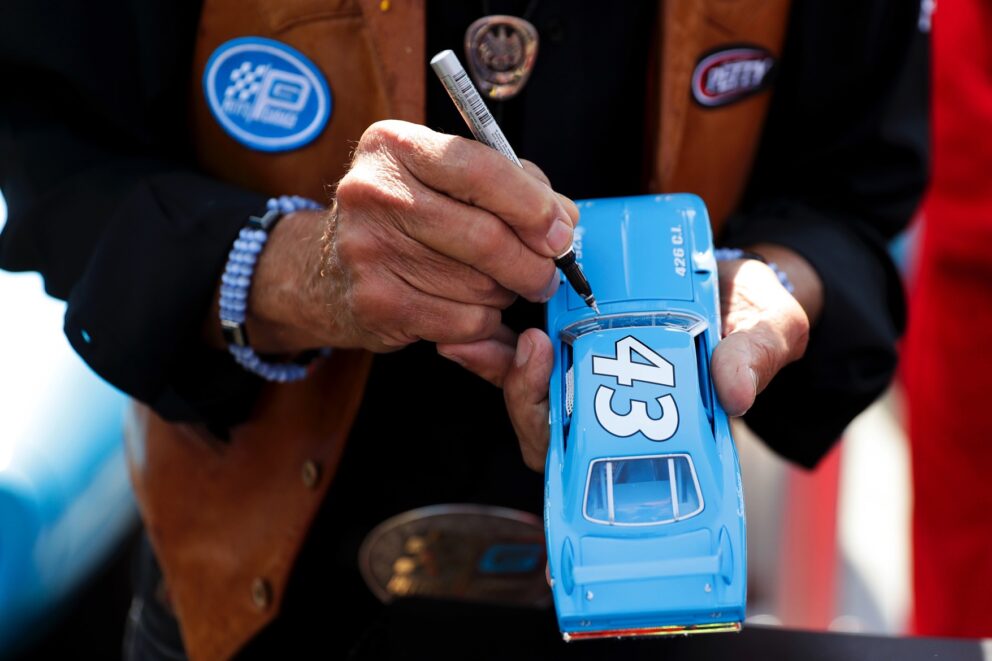
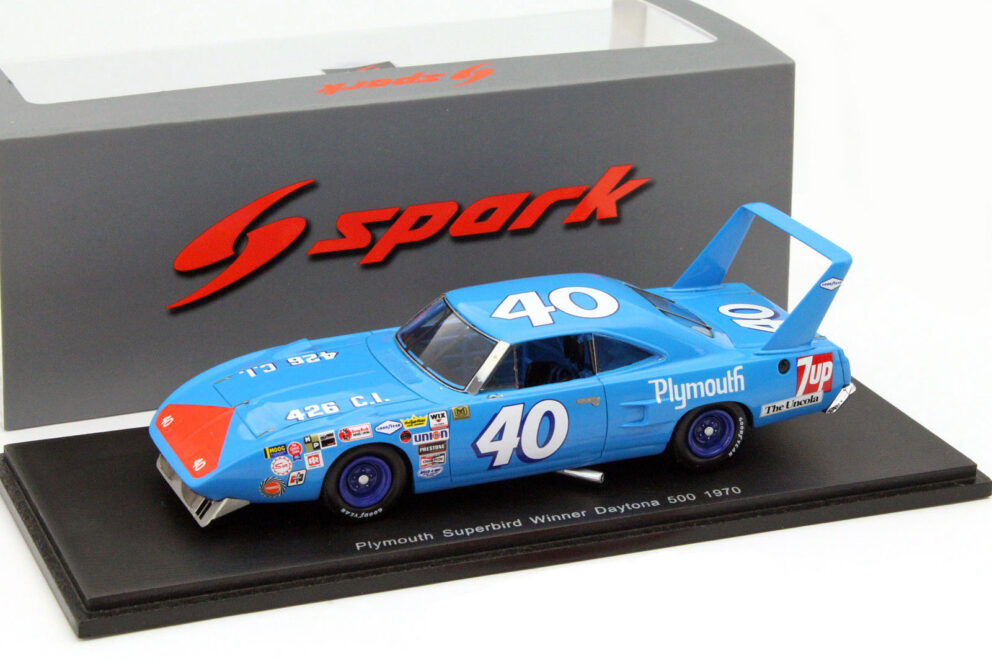
Over the years, there’s been a number of 1:18 scale diecasts of the #43 Superbird (RC2 Ertl version shown) and it’s an extra bonus to possess one signed by The King himself! Richard took a penmanship class in business college back in the day and when he started to get requests for his autographs, he decided to make it more elaborate than normal, he felt it was an honor and a way to thank his supporters. (Richard has been known to stand for hours signing his name for fans until the very last person had requested it.)
The #40 Pete Hamilton Petty Superbird shown is 1:43 scale from Spark.
THE KING AND DISNEY
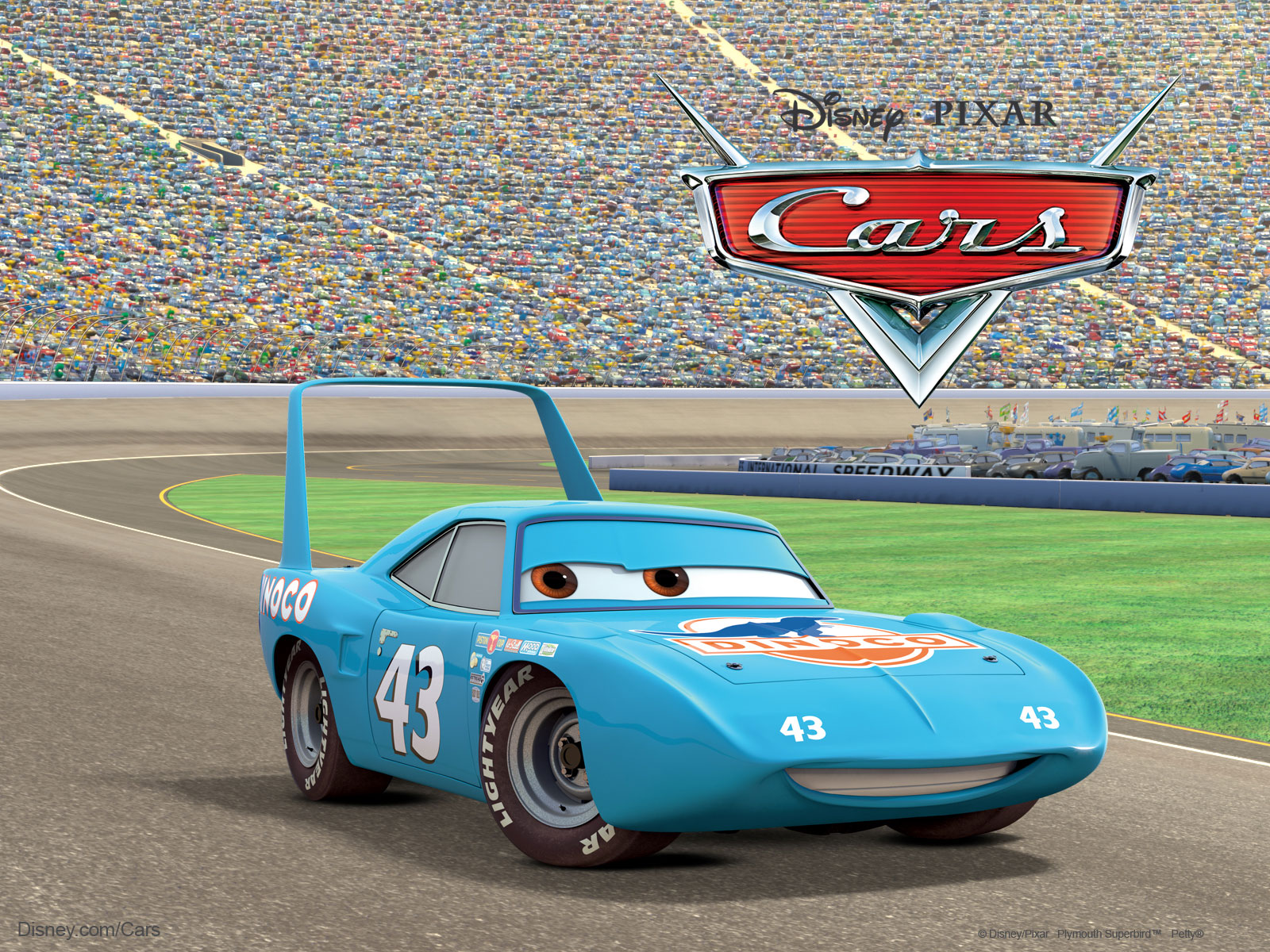
It was Strip “The King” Weathers (voiced by Richard Petty) in the popular 2006 Disney/Pixar animated film Cars that featured an anthropomorphic version of the famous #43 Superbird racecar. This was a fabulous way to introduce the legend Richard Petty to those young viewers!
PETTY’S GARAGE
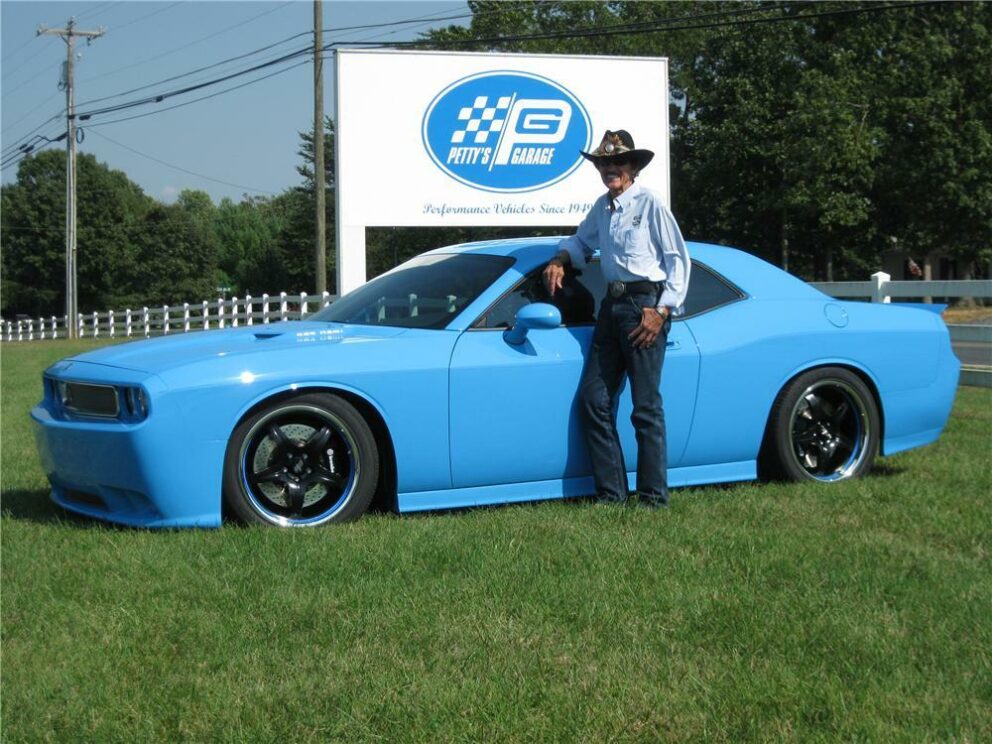
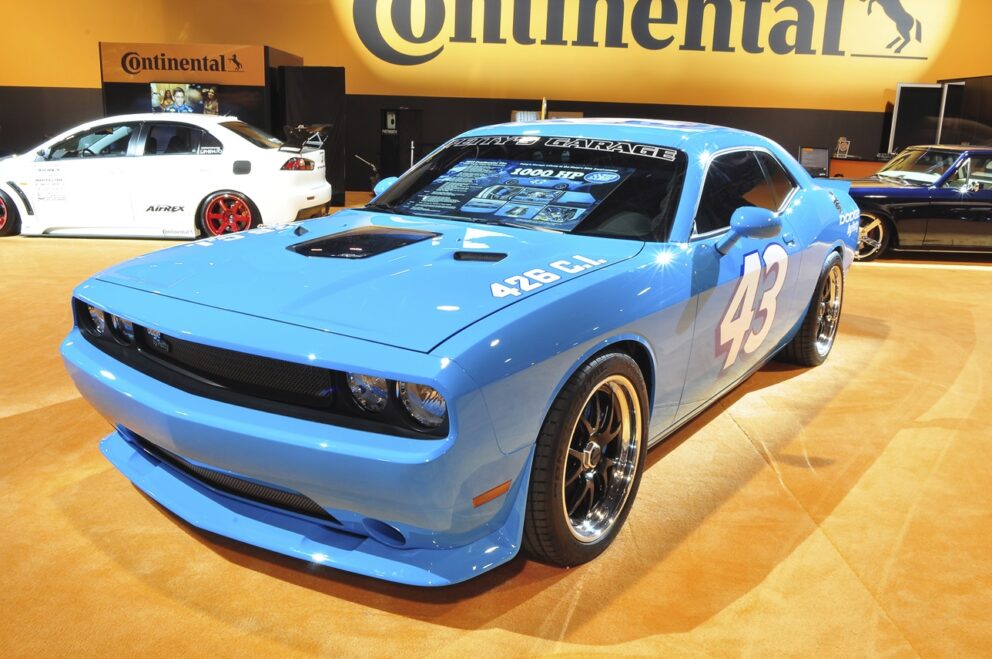
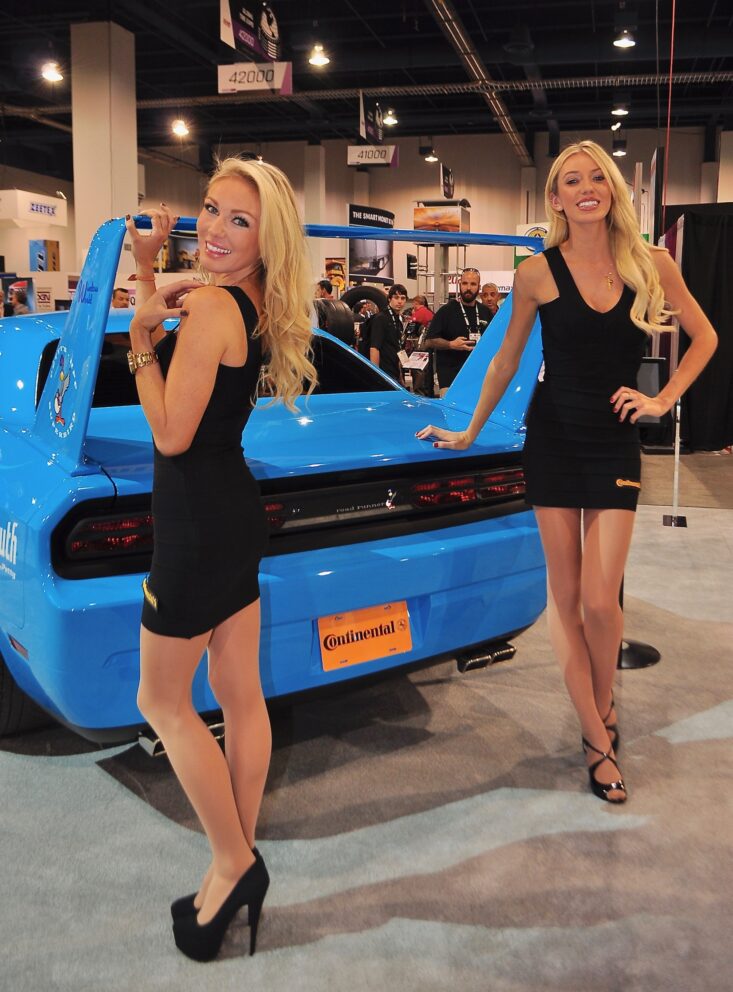
The Dodge Challenger made the perfect platform for customized cars to be built from The Petty Garage, specially modified and powered by the GEN III HEMI engines. Located in Level Cross, North Carolina, this facility, since 2008, sells parts and builds cars with that “Petty touch” and the color Petty Blue is a common denominator with the customer vehicles. They’ve done up “Superbird”-type Challengers and typically each SEMA Show in Las Vegas has their latest creations displayed!
Check out this video that combines the “Petty Blue” song with some Petty Blue being applied to a Dodge Charger racecar:
Author: James Maxwell

0 Comments